
archives for 08/2010
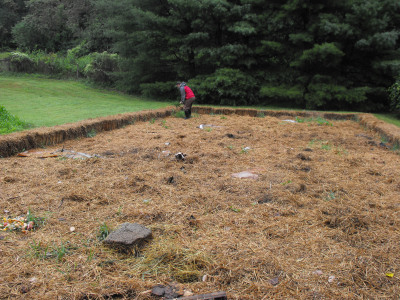 Everett and Missy (from Living a Simple Life) were kind enough to invite
us over to
their new homestead for lunch on Saturday and I leapt at the
offer. There are few things I like better than a farm tour --- a
great chance to walk around someone else's operation and get ideas.
Everett and Missy (from Living a Simple Life) were kind enough to invite
us over to
their new homestead for lunch on Saturday and I leapt at the
offer. There are few things I like better than a farm tour --- a
great chance to walk around someone else's operation and get ideas.
The farm was beautifully
manicured (way out of my weed-overgrown league), and I'm sure lots
of you would love to see pastoral photos. However, being who I
am, I took a few pictures of the chickens and then a whole bunch of
pictures of the garden.
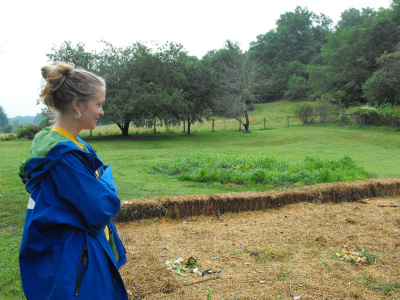
Everett and Missy made
the wise choice to spend their first year on the farm focusing on
infrastructure, but they didn't ignore the garden entirely.
Instead, they planted a few cucurbits down by the creek, hired a nearby
farmer to plow up a field to plant a clover cover crop in a second
area, and then spread thick straw mulch over a third area.
This third area, of
course, was the one that caught my eye --- a patch of lawn being
transformed into a budding Ruth
Stout garden.
Mushrooms were already hard at work improving the soil, and worms had
clearly been attracted to the moist, bare soil beneath the 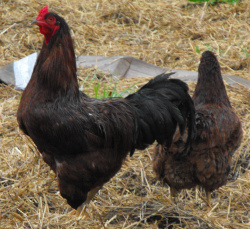 mulch.
The couple's free range Buckeye chickens loved scratching up
the mulch to find critters...and depositing their own organic
fertilizer in exchange. I wouldn't be surprised if this plot
turns into a bountiful and trouble-free garden next year.
mulch.
The couple's free range Buckeye chickens loved scratching up
the mulch to find critters...and depositing their own organic
fertilizer in exchange. I wouldn't be surprised if this plot
turns into a bountiful and trouble-free garden next year.
Of course, we didn't
escape the farm tour entirely unscathed. Like they say, August is
the only time you have to lock your car in Appalachia --- otherwise,
you'll come back to discover it full of zucchinis. Thanks for the
produce, the delicious lunch, and the tour!
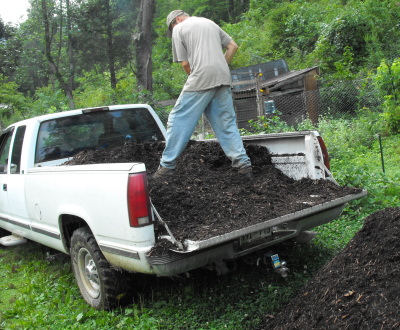
Although The
Mulch Company has a fine product with great service, we've decided
their price is too high.
Anna's mulch instinct is
telling her we can get more for less somewhere else, and when it comes
to mulch I choose to yield to her organic intuition.
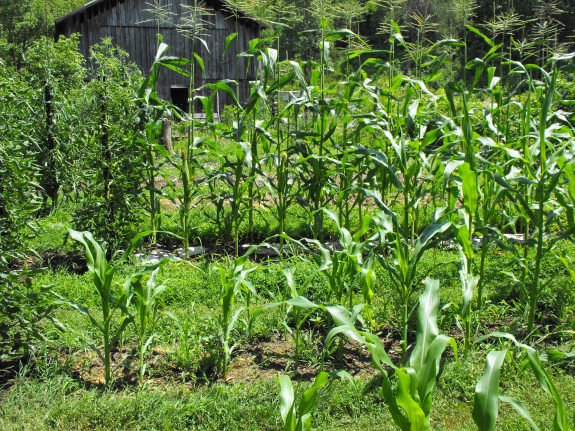
Congratulations to
Bladerunner, the winner of our most recent
giveaway!
Bladerunner, drop me an email with your t-shirt size and
we'll get your prizes out to you as soon as possible.
Thanks to everyone who helped spread the word! Don't despair if
you didn't win --- we'll start up another giveaway before long.
Since this is a light
post, I thought I'd throw in a photo I've been saving for a couple of
weeks. There's not really much to say about it, except that
succession planting corn is the best way to sweeten dinners all summer
long. Sweet corn patch part two is about to hit the plate....
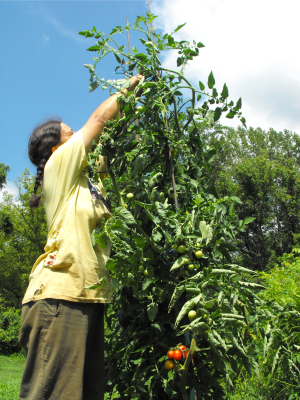 Last
year, the blight took me by surprise and sent me reeling. Since
then, I've done a lot of plotting and researching, and I feel like I
have the possibility of harvesting a crop after the fungus hits.
Last
year, the blight took me by surprise and sent me reeling. Since
then, I've done a lot of plotting and researching, and I feel like I
have the possibility of harvesting a crop after the fungus hits.
I've talked about our
extreme tomato pruning
before, but I want to add a few notes since I can already tell that I'll be pruning slightly
differently next year. Most importantly, I plan to snip off the
bottom leaves repeatedly rather than spending my weekly pruning
sessions solely cutting back suckers and tying up the main stems.
I've noticed that even leaves attached a foot above the ground bend
downward with age until they are dipping into the splash zone.
Unsurprisingly, the first symptoms of the blight show up as yellowing
and browning of these leaves --- a sign that fungal spores are being
exposed to the air. In the future, I'll clip off low leaves as
soon as they droop.
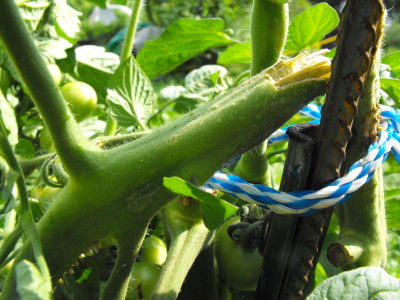
| This post is part of our Organic Tomato Blight Control lunchtime
series.
Read all of the entries: |
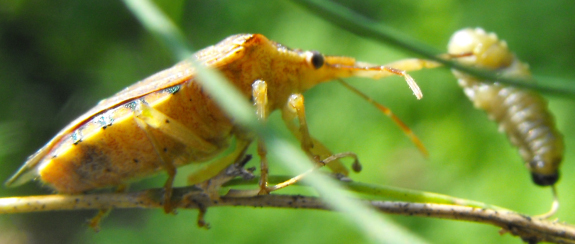
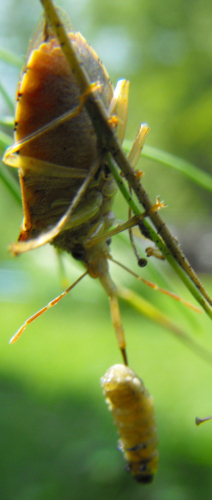 Stink
bugs are usually bad news in the garden. They suck the juices out
of your plants and the chickens won't even eat them because of the
Stink
bugs are usually bad news in the garden. They suck the juices out
of your plants and the chickens won't even eat them because of the
 noxious fluid they squirt out when disturbed. But if I'm honest,
my antipathy toward the insects dates from childhood. You see,
stink bugs love blackberries, and so do I. Pop a blackberry in
your mouth without looking and there's a good chance a stink bug might
come along for the ride, leaving the most awful taste in your mouth
imaginable.
noxious fluid they squirt out when disturbed. But if I'm honest,
my antipathy toward the insects dates from childhood. You see,
stink bugs love blackberries, and so do I. Pop a blackberry in
your mouth without looking and there's a good chance a stink bug might
come along for the ride, leaving the most awful taste in your mouth
imaginable.
Despite my scarred
childhood, stink bugs have now been redeemed in my eyes. I was
out on my weekly bug-picking expedition Monday, squashing asparagus
beetle larvae and
tossing all of the other bad bugs into a cup of water to give to the
chickens. Guess who was already helping with the asparagus beetle
control? This predatory stink bug uses its long proboscis to spear
insects and drain them dry rather than sucking a plant for lunch.
I'm glad I decided to
use manual control this year on our insects, even though it is a bit of
a pain to pick bugs for an hour a week during the growing season.
I've noticed spiders, ladybugs, and now this stink bug moving into the
asparagus, keeping the beetle populations in check. Maybe in a
few years, our beneficial insect populations will be so healthy that I
won't have to hand-squash larvae?
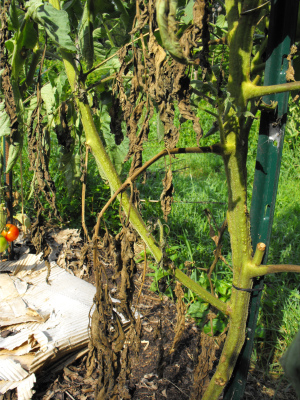 But
what do you do if, despite preventative pruning, your tomatoes begin to
show signs of late blight?
Rather than sticking your head in the sand the way we did last year,
your best bet is to take decisive action immediately. Single out
any tomatoes on which the blight has progressed beyond the very lowest
leaves and delete the entire plant. Then clip off any blighted
lower leaves on nearby plants.
But
what do you do if, despite preventative pruning, your tomatoes begin to
show signs of late blight?
Rather than sticking your head in the sand the way we did last year,
your best bet is to take decisive action immediately. Single out
any tomatoes on which the blight has progressed beyond the very lowest
leaves and delete the entire plant. Then clip off any blighted
lower leaves on nearby plants.
During this extensive
pruning expedition, you should wipe your clippers with a rag soaked in
alcohol every time you move from one plant to another, or from a more
blighted area to a less blighted area. In addition, you shouldn't
even think about going into a blighted tomato patch when dew or rain
are heavy on the plants --- blight spores move around and germinate on
wet surfaces.
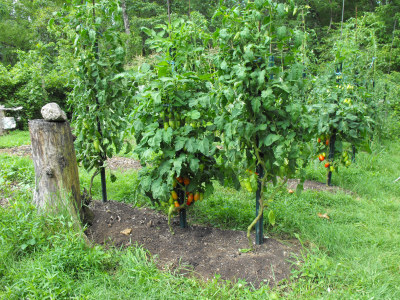 This
is also the one time I advocate removing biomass from the farm.
You should definitely not incorporate the blighted tomato residue into
your compost pile, but I feel that it's dicey to even toss it off into
the bushes at the edge of the woods. Instead, I actually let Mark
haul our blighted tomato parts away to the dump.
This
is also the one time I advocate removing biomass from the farm.
You should definitely not incorporate the blighted tomato residue into
your compost pile, but I feel that it's dicey to even toss it off into
the bushes at the edge of the woods. Instead, I actually let Mark
haul our blighted tomato parts away to the dump.
Finally, I take the
first sign of blight as a signal to get realistic. All of your
hard work pruning off diseased foliage is not going to cure your tomato
patch of the blight --- it will merely slowly the disease's
spread. You might be able to stay ahead of the blight for a while
by removing any yellow or brown leaves, but you'll have to stay
vigilant. So harvest while you can!
| This post is part of our Organic Tomato Blight Control lunchtime
series.
Read all of the entries: |
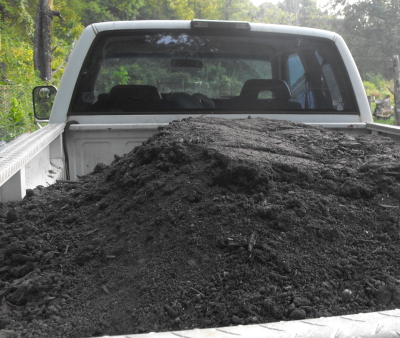 We
tried a new mulch source that has more down to Earth prices than The Mulch
Company... including a
sale on compost for just 10 bucks a scoop.
We
tried a new mulch source that has more down to Earth prices than The Mulch
Company... including a
sale on compost for just 10 bucks a scoop.
Don't get too excited. Their
"compost" was just aged wood chips mixed in with average looking dirt.
I still took 2 scoops because
I wanted to believe the lady at the desk when she said it was just
"pure aged wood chips", and I was a bit fatigued from following a map
that was not quite accurate on what may have been one of the hottest
days of the year.
I knew right away something
was amiss when Anna didn't get that same giddy laughter of joy I've
become so accustomed to when I bring truckloads of compost home.
"We can still use it for
areas in the forest garden where the clay doesn't drain well," she
said trying to make me feel better.
BFR Mulch in Norton has a
distorted definition of compost, but I guess it's a subjective term that
will vary from person to person. The stuff will make okay raised bed
material, but was barely worth hauling home when you gauge it on the
Anna meter.
They have aged oak mulch for
21 dollars a scoop, which is what we'll try next.
 The
dry season makes for good conditions to catch up on some minor ford
maintenance.
The
dry season makes for good conditions to catch up on some minor ford
maintenance.
The do it
yourself cinder block ford hasn't really needed much repair in the
past 4 years. This turns out to be a low budget creek crossing
solution that continues to work.

During World War II, 40%
of American vegetables came from 20 million victory gardens. With
American men fighting abroad, women were raising their kids alone,
working outside the home (to fill those men's jobs), and still finding
time to till up their backyard and grow food for their families.
(Doesn't that make you
feel a bit silly for saying you don't have time to plant a
garden? There's still time to put in lettuce and greens for the fall, by the way.)


Posters like these from
both World Wars admonished women to plant a garden, can and dry the
excess, and never waste a crumb. The propaganda definitely worked
--- Americans ate potatoes instead of wheat so that the less perishable
grain could be sent abroad, and they generally managed to subsist on
what those remaining at home could grow.
As Sharon Astyk pointed
out in her fascinating
analysis of why and how we have been trained to believe that our
individual consumer choices make no difference to the world, victory gardens are clear
proof that your personal actions can have a worldwide impact.
Leading by example, you can even suck your friends and family into a
mode of eating that is lighter on the earth.
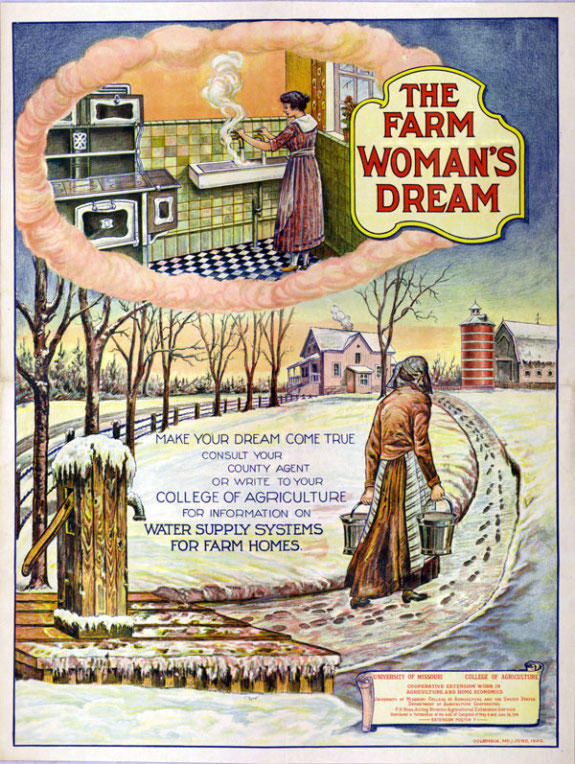
 But
after the war ended, the propaganda took an abrupt about-face.
Suddenly, posters were telling us to buy, buy, buy! And, once
again, we followed along like sheep, dropped our shovels, and went out
to spend some money.
But
after the war ended, the propaganda took an abrupt about-face.
Suddenly, posters were telling us to buy, buy, buy! And, once
again, we followed along like sheep, dropped our shovels, and went out
to spend some money.
While I'm tempted to
talk here about our current government's admonitions to spend money to
prop up our ailing economy rather than striving to become more
self-sufficient, frugal, and debt-free on a personal level, I
won't. Instead, I think the takeaway message from the victory
garden campaign is clear --- think globally, act locally. If you
believe that the environment would benefit from food grown in an
ecologically conscious way, then look into permaculture and plant a
diversified garden. Anyone living anywhere can plant something,
preserve something, and cut back on food waste.
To see the source of
these posters (and peruse many more --- huge time sink, I warn you),
visit Beans
are Bullets, a
website/exhibition put together by the National Agricultural
Library.
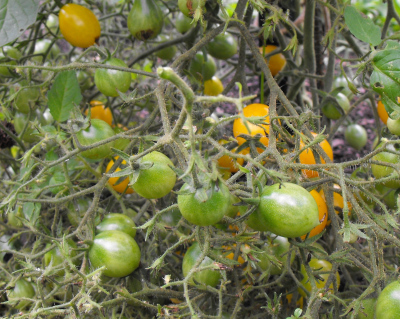 The
agricultural extension websites are quick to tell you that no tomato
variety is immune to the blight, but I've discovered that several are
resistant. In general, tommy-toes
seem to fare quite well, losing the battle much later than the
larger-fruited varieties. On the other hand, the Green Zebra we
were testing for the first time this year turned out to be the most
blight-prone of any of our tomatoes --- we won't grow Green Zebra
again. So far, all of our other slicing tomatoes are faring
pretty well.
The
agricultural extension websites are quick to tell you that no tomato
variety is immune to the blight, but I've discovered that several are
resistant. In general, tommy-toes
seem to fare quite well, losing the battle much later than the
larger-fruited varieties. On the other hand, the Green Zebra we
were testing for the first time this year turned out to be the most
blight-prone of any of our tomatoes --- we won't grow Green Zebra
again. So far, all of our other slicing tomatoes are faring
pretty well.
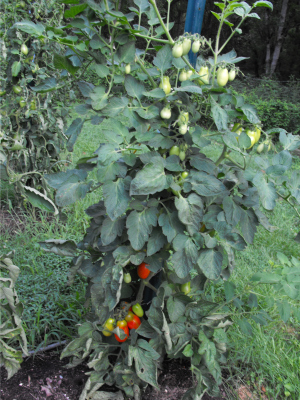
The heart of our tomato
patch is our romas, and I'm starting to get a feel for which
roma varieties last longer when blight is in the air.
Large-fruited romas do the worst, and I don't think I'll even save
seeds from Italian San Rodorta this year since the plants blight so
quickly. In contrast, the even more hefty-fruited Russian Roma
plants are only barely blighted. Yellow Roma and Martino's Roma
are currently my roma winners --- the fruits are small, but they ripen
quickly and copiously, and the plants are blight-free so far.
I suspect that if I
tweaked my plantings to focus solely on the most blight-resistant
varieties, the fungus might not enter our patch until weeks
later. Or not at all?
| This post is part of our Organic Tomato Blight Control lunchtime
series.
Read all of the entries: |

Marcus Sabathil is a glass artist and furniture
maker who managed to modify
his Toyota Previa in such
a way to increase highway mileage from 20 to 36 mpg.
I've often wondered how much
of a gain we might get from our Toyota Previa if we fabricated a
similar boat tail.
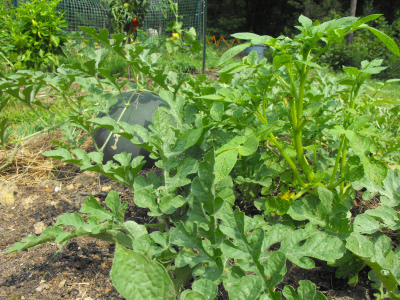 While
weeding the mule garden this week, I discovered an unintentional
polyculture. I had pulled out all the seed potatoes from my fall
potato experiment because they weren't sprouting --- or so I
thought. It turns out that one potato was overlooked, and it
popped up between the leaves of a watermelon I'd planted at the end of
the bed.
While
weeding the mule garden this week, I discovered an unintentional
polyculture. I had pulled out all the seed potatoes from my fall
potato experiment because they weren't sprouting --- or so I
thought. It turns out that one potato was overlooked, and it
popped up between the leaves of a watermelon I'd planted at the end of
the bed.
Meanwhile, my primary
purpose for the bed was to plant fall carrots. I seeded three
different beds with carrots this summer, but very few seedlings
came up in two of the beds. However, in my polyculture bed, the
watermelon took off and ran across the carrot area, shading the soil
and retaining 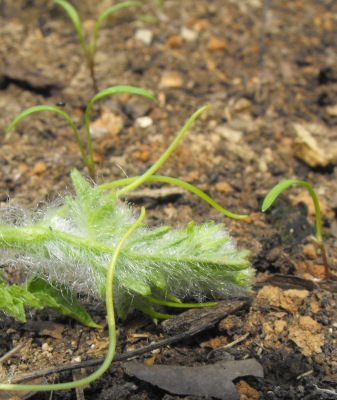 enough moisture for the seeds to sprout.
All three
vegetables seem to be growing quite happily together so far, though I
recently
moved the watermelon tendrils aside to give the baby carrots room to
grow.
enough moisture for the seeds to sprout.
All three
vegetables seem to be growing quite happily together so far, though I
recently
moved the watermelon tendrils aside to give the baby carrots room to
grow.
In the interest of full
disclosure, I have to admit that the carrot seeds in the other beds may
have had shoddy germination rates because they were a different variety
than those sown in the polyculture bed. I usually have very good
luck with Jung's Sweetness hybrid carrots, but the pack this year seems
to have been a dud --- germination was low in our spring carrot bed
too. Next year, I might change my loyalties to one of the seed
companies recommended by Steve Solomon.
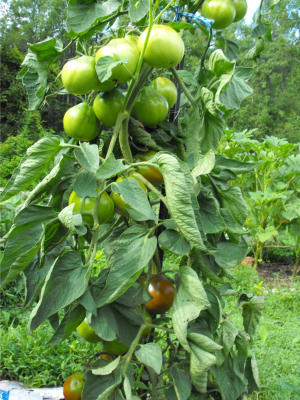 I
like to call step four in our campaign against the tomato blight
"tomato islands." While it's quite true that blight spores can
travel up to a mile in damp weather, planting patches of tomatoes in
different parts of the garden can be relatively effective in keeping
the blight from spreading if the summer stays hot and dry. So
while our romas (and a few slicers) are all clumped together along the
sunniest
edge of the mule garden, I've got slicing tomatoes and tommy-toes in
three other areas. The ones in the far-off front garden still
seem to be blight-free.
I
like to call step four in our campaign against the tomato blight
"tomato islands." While it's quite true that blight spores can
travel up to a mile in damp weather, planting patches of tomatoes in
different parts of the garden can be relatively effective in keeping
the blight from spreading if the summer stays hot and dry. So
while our romas (and a few slicers) are all clumped together along the
sunniest
edge of the mule garden, I've got slicing tomatoes and tommy-toes in
three other areas. The ones in the far-off front garden still
seem to be blight-free.
I'm also taking a page
out of our neighbor's book. Last year, while touring a friend's
garden at the end of the summer, I saw that he had a healthy tomato
plant still spitting out fruits. "How did you do that?!"
I exclaimed, and he told me that he'd thrown some seeds in the ground
in early June. This year I followed suit and seeded three more
tomato plants a couple of weeks after our frost-free date. These
late plants are starting to set fruits, and so far look pristine.
Perhaps they will give us a fall harvest?
| This post is part of our Organic Tomato Blight Control lunchtime
series.
Read all of the entries: |
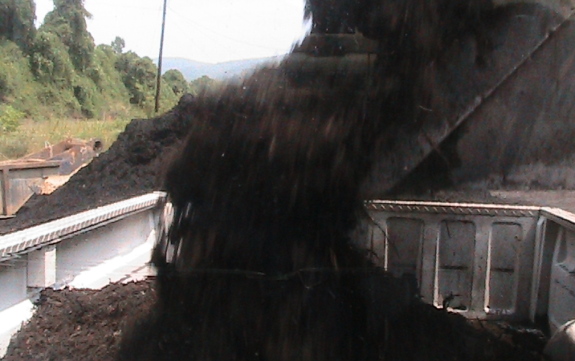
I went back to BFR Mulch for two scoops of aged oak mulch
today.
It's an excellent product
that made Anna smile when she noticed the rich organic smell.
It was 21 bucks per scoop,
which is about half of what The Mulch
Company demands for
their mulch which is made from pine.
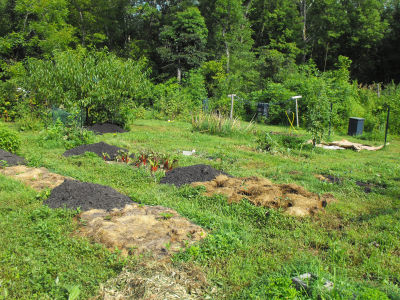 Our
back garden is a trouble spot. As I've mentioned before, previous
owners had a pasture there and I suspect allowed all of the topsoil to
erode away. What's left is dense clay over a high water table ---
a recipe for crop failure.
Our
back garden is a trouble spot. As I've mentioned before, previous
owners had a pasture there and I suspect allowed all of the topsoil to
erode away. What's left is dense clay over a high water table ---
a recipe for crop failure.
And then there are the
problems that are my own fault. When I built the back garden's raised
beds,
I believed it was best to merely scoop up the topsoil from the aisles
to create the beds. But there was so little topsoil present that
the beds turned out to be barely higher than the surrounding
aisles. A couple of years later, the beds have collapsed a bit
more,
which means that the grass and clover in the pathways encroach
constantly on the "beds", and grass seeds also drift up into the
growing area
as a matter of course. Yet more problems.
Again my fault --- I was
new to pathway planning when I laid out the
back garden, so for some reason I can no longer fathom, I created a
checkerboard of tiny beds. Mowing takes twice as long since you
have to go across the garden horizontally, then again vertically.
Yuck! Can you tell this is my least favorite gardening spot?
I took advantage of Mark's
load of topsoil (aka "compost")
to start fixing all of the back garden's problems. First step ---
merge all of the beds on a contour line into a single long bed by
dumping topsoil in the dividing aisles. Suddenly, I wanted two
more truckloads of soil so that I could also build up the empty beds
(which had been planted in buckwheat and are waiting to be planted in
oats next week.) My goal is to create a replica of my current
favorite garden --- the mule garden --- with long raised beds at least
six inches high. Then I could start to consider the high
groundwater a boon --- subirrigation!
 The
final element of our tomato campaign is "never waste a tomato."
Mark and I completed our vine-ripened
versus indoor-ripened tomato taste test
last week, concluding that the former had just a hint of extra
flavor. Still, the kitchen-ripened tomatoes were ten times better
than storebought. So when I had to pull out three blighted tomato
plants last week, I first picked every tomato that had at least begun
to whiten and am now ripening them under the kitchen counter.
The
final element of our tomato campaign is "never waste a tomato."
Mark and I completed our vine-ripened
versus indoor-ripened tomato taste test
last week, concluding that the former had just a hint of extra
flavor. Still, the kitchen-ripened tomatoes were ten times better
than storebought. So when I had to pull out three blighted tomato
plants last week, I first picked every tomato that had at least begun
to whiten and am now ripening them under the kitchen counter.
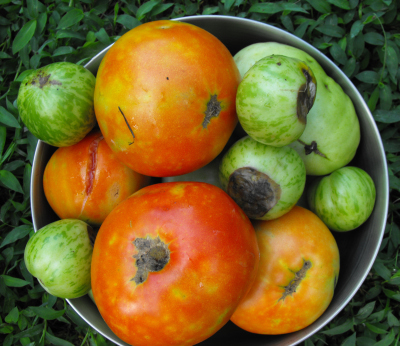 Meanwhile,
fruits with a bit of blossom end rot or a cosmetic crack are fine additions to sauce
--- just slice off the troubled spot. On the other hand, our volunteer tomato
plant turned out not to be worth saving even under these drastic
conditions. I suspect the volunteer came from a storebought
tomato seed, because fully two thirds of the fruits that I left on the
vine to ripen rotted before turning red. I guess those hard, pink
tomatoes in the grocery store don't
ripen all the way, no matter what you do. That vine came out to
give more space to its neighbor.
Meanwhile,
fruits with a bit of blossom end rot or a cosmetic crack are fine additions to sauce
--- just slice off the troubled spot. On the other hand, our volunteer tomato
plant turned out not to be worth saving even under these drastic
conditions. I suspect the volunteer came from a storebought
tomato seed, because fully two thirds of the fruits that I left on the
vine to ripen rotted before turning red. I guess those hard, pink
tomatoes in the grocery store don't
ripen all the way, no matter what you do. That vine came out to
give more space to its neighbor.
| This post is part of our Organic Tomato Blight Control lunchtime
series.
Read all of the entries: |
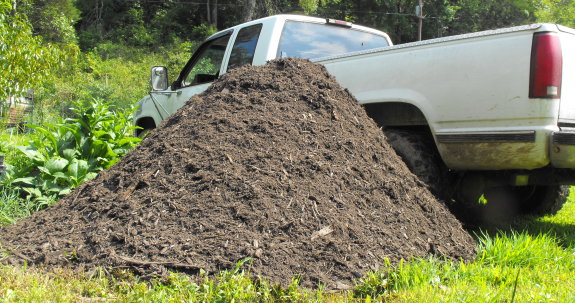

My last trip to BFR
Mulch in Norton gave me a chance to ask the guy about delivery
options.
It seems they have a small
Mitsubishi 4 wheel drive dump truck that can haul 5 times what we can
do in the truck. The delivery fee is 30 dollars from Norton to Coeburn, which
is about the half way mark for us and why the guy guessed the charge to
be around 60 bucks for our zipcode.
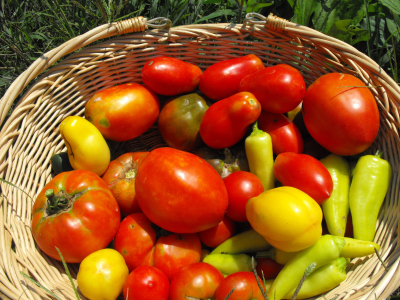 I've
been putting a lot of thought lately into how we invest the fruits of
our labors. A decade ago, I read a basic investment book that
told me to put 10% of my income in a mutual fund for retirement, and
I've been following along like a sheep ever since.
I've
been putting a lot of thought lately into how we invest the fruits of
our labors. A decade ago, I read a basic investment book that
told me to put 10% of my income in a mutual fund for retirement, and
I've been following along like a sheep ever since.
But investing in a
combination of stocks and bonds means that I believe in a growth economy. Do I? I
certainly don't believe a growth economy is good, and I'm not so sure
that I believe our economy will grow over the next forty years.
On the other hand, I
don't really believe in apocalyptic scenarios either, so I don't plan
to invest in gold. (As Mark pointed out, coins worth over a
thousand dollars apiece are unlikely to be terribly useful in an
apocalyptic scenario anyway.) I'm guessing social security will
be around when I retire, but may only pay out half of what my
statements tell me to expect. Perhaps our best bet is to put our
dribs and drabs of retirement money in some combination of ultra-safe
investments (like CDs) and into farm infrastructure to make our annual
operating costs lower.

I'm curious to hear our
readers' take on investment in today's climate. Do you stick to
the rosy view that the economy will rebound, meaning that social
security will fulfill most of your needs and you'll round out your
retirement income with some sort of mutual fund? Or do you think
society as we know it will collapse and social security will be
completely absent, so you'd better stock up on firearms? I'm most
curious to hear from folks who think the future will be somewhere in
the middle --- how do you invest for your old age?
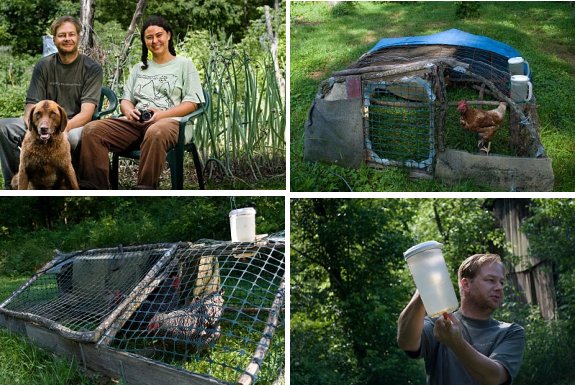
Big thanks go out to Travis and
Kacy for the nice
post they wrote about us.
They're still on the cross
country journey and have visited about 90 farming types.
I'm looking forward to
reading their book about these travels which now has a working title of
"Stewards: Stories and Perspectives From American Farmers".
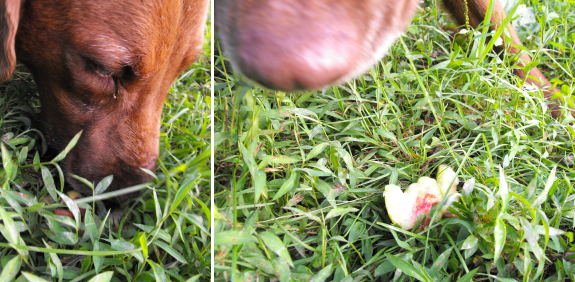
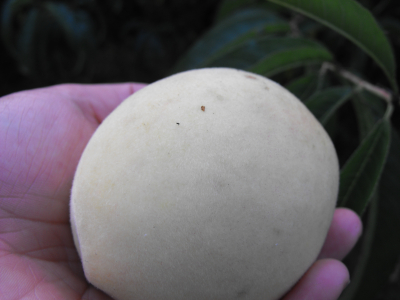 "Lucy,
where did you find a brand new tennis
ball?" I asked our frugivorous dog, catching sight of a yellowish
sphere in her mouth. She dropped...the first peach from our kitchen
window peach tree.
Then promptly gulped it down, pit and all.
"Lucy,
where did you find a brand new tennis
ball?" I asked our frugivorous dog, catching sight of a yellowish
sphere in her mouth. She dropped...the first peach from our kitchen
window peach tree.
Then promptly gulped it down, pit and all.
I had smelled the scent
of ripe fruit wafting from the tree as I walked
past earlier that morning, but I was so sure the peaches weren't
ripe. You see, I had planted a Loring peach in that spot three
years ago --- a
yellow-fruited variety with a nice red blush on the skin. And the
fruits on my tree were steadfastly pale yellow with white flesh.
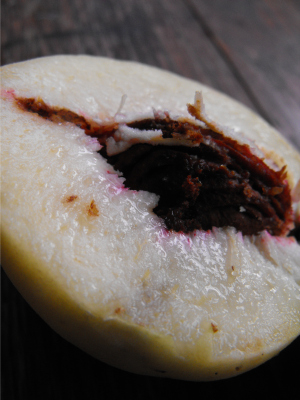
But Lucy likes her fruit
ripe, so I went back to check again. Sure
enough, the peaches were just barely starting to ripen, even though the
flesh was pale as can be. What's the statute of limitations on
complaining about being given the wrong tree variety?
The trouble is, I adore
yellow peaches, while white peaches are
considerably lower on the totem pole --- like the difference between
strawberries and blackberries. Luckily, I have another peach tree
out back that's one year younger but already gave me four little
peaches with great flavor and bright orange flesh. By next year,
I should be glutted with yellow peaches. But what to do in the
meantime? Perhaps I need to check out some recipes for peach
leather? Now's your chance to shower us with your favorite peach
recipes.
 The new
tomato support structure is helping our plants reach towards the
sky.
The new
tomato support structure is helping our plants reach towards the
sky.
This one is already over 7
feet tall, which might require a step ladder to harvest the ones up
high.
The Master Gardeners of Santa
Clara County in California evaluated
11 different ways to support tomatos and summed up the pros and
cons of each in an easy to read report from 2001.
They used just over 100
varieties of mostly heirloom tomatos to finally get to the bottom of
which system works the best.
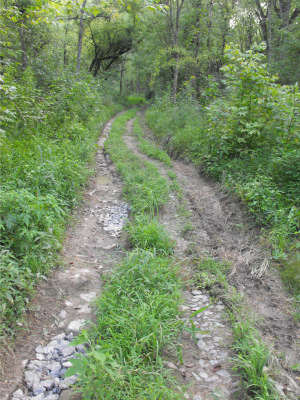 Perhaps
in other parts of the world, it's not considered abnormally dry when
you've had a steady one inch of rain per week for most of the
summer? Around here it sure feels dry, though, after a month with
abnormal highs in the nineties nearly every day. The floodplain has dried up, meaning that
even though there are puddles of water in the driveway, the ground
between is hard rather than mud. Perfect weather for hauling.
Perhaps
in other parts of the world, it's not considered abnormally dry when
you've had a steady one inch of rain per week for most of the
summer? Around here it sure feels dry, though, after a month with
abnormal highs in the nineties nearly every day. The floodplain has dried up, meaning that
even though there are puddles of water in the driveway, the ground
between is hard rather than mud. Perfect weather for hauling.
Last winter, when we
were trying to ferry in building supplies through endless muck, Titus
gently noted that she tries to do all of her hauling during the dry
season. So when we realized the driveway was firm enough to allow
Joey's truck to pass through, we dropped everything from the list and
instead focused on ferrying supplies into the farm. That's why
Mark went to town nearly every day last week, hauling in compost and mulch. It wasn't photogenic
enough to post about, but he also hauled out a year's
supply of household garbage --- a truckload and a half
full.
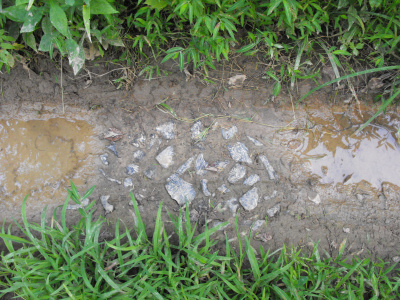
We hope to finish
bringing in the year's supply of biomass this week, and also cut up and
haul in firewood from deadfall trees along the driveway. Round it
all out with some lumber for the solar dehydrator and picnic table
projects, and we should be done hauling for a long, long time. I
just thought you all deserved an explanation so that you didn't think
we were on a crazy spending spree.
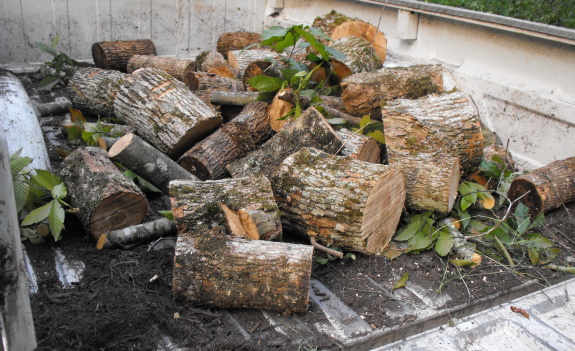
This round of firewood
cutting reminded me of a saying my uncle Art once told me.
I think I've cheated myself
out of one
of the warmings by cutting on a day like today, but I think it's
still worth the effort nonetheless.
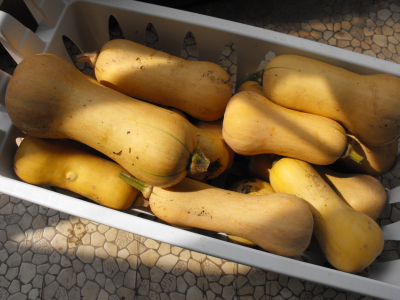 "Look
at all the butternuts I harvested,
honey!" I said proudly. "And we've got four more left in the
garden."
"Look
at all the butternuts I harvested,
honey!" I said proudly. "And we've got four more left in the
garden."
Mark glanced over at my
22 pounds of butternuts and replied --- "Four
more baskets?" Shame-faced, I had to shake my head no. I
only had four more squash in the garden.
The truth is that when I
planned our three butternut beds this year, I
should have realized that Mark had turned a general preference for
these winter squash into an outright craving. Already, he's
talking about buying some butternuts from a friend, and he has the
right idea. Now's the perfect time of year to stock up on any
vegetables of which you have an unexpected shortfall (or ones that your
husband suddenly decides he adores and wants three times as
many of.)
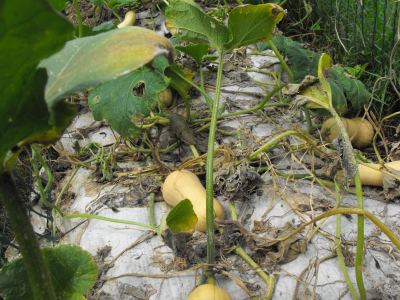 If
you planted your butternuts a bit late (which would have been
smart), they might not be ready to harvest yet. Wait until your
vines are dying back, your fruits are fully tan, and the stems have
begun to brown (but be absolutely certain to harvest before the first
frost.) Then carefully cut each butternut off the vine, leaving
an inch of stem on the fruit. Never toss the butternuts around
--- even though they look hardy, they actually bruise quite quickly if
treated harshly.
If
you planted your butternuts a bit late (which would have been
smart), they might not be ready to harvest yet. Wait until your
vines are dying back, your fruits are fully tan, and the stems have
begun to brown (but be absolutely certain to harvest before the first
frost.) Then carefully cut each butternut off the vine, leaving
an inch of stem on the fruit. Never toss the butternuts around
--- even though they look hardy, they actually bruise quite quickly if
treated harshly.
Some people wash their
butternuts gently in a solution of bleach water
after harvesting to kill off any fungi living on the skin, but I've had
good luck storing our butternuts as is. For best flavor, allow
the squash to cure at 80 to 85 degrees Fahrenheit for a couple of
weeks, then store in a cool (50 to 60 F), dry place. We keep our
butternuts in a kitchen cabinet and eat them until the middle of the
winter...or until we run out.

When we first started off
clearing away the driveway we were using a very small pruning chainsaw
because we didn't know any better and funds were limited.
We finally realized the
limitations and decided to splurge for a bigger saw. We found a good
deal on a much bigger chainsaw through E-bay, and used it to finish
clearing the path.
It's a Stihl 039, or what they call a 390 these
days. A fine machine, but after it's all said and done I think we would
have been better off with a smaller one. It gets real heavy real fast,
especially after you've been cutting for a while.
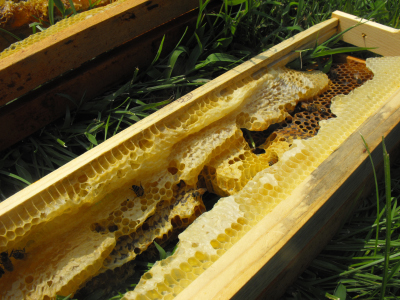 After
extracting four and a
half gallons of honey from our hives, I proceeded to ignore them
for over a month. We had more pressing matters on our plate (like
killing
all of our broilers),
and I figured, what could go wrong now that we've taken out a lot of
honey and the hives are all built up to summer levels? I should
have known that I had more beginner mistakes ahead of me.
After
extracting four and a
half gallons of honey from our hives, I proceeded to ignore them
for over a month. We had more pressing matters on our plate (like
killing
all of our broilers),
and I figured, what could go wrong now that we've taken out a lot of
honey and the hives are all built up to summer levels? I should
have known that I had more beginner mistakes ahead of me.
When I opened up the
east hive on Tuesday, everything looked fine in the top super.
But the next level down was a disaster. Every frame (most of them
at least half full of honey) 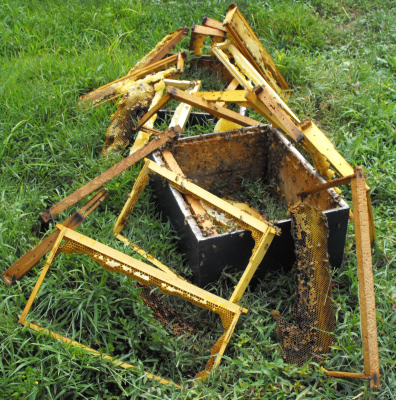 had
collapsed under this summer's extreme heat, turning horizontal so that
they blocked the flow of air out of the hive. Small surprise that
the next level down was completely collapsed as well. Only the
lowest brood box (thank goodness!) still had vertical frames of wax.
had
collapsed under this summer's extreme heat, turning horizontal so that
they blocked the flow of air out of the hive. Small surprise that
the next level down was completely collapsed as well. Only the
lowest brood box (thank goodness!) still had vertical frames of wax.
The honey was mostly
uncapped, so I couldn't extract it. Instead, I yanked out all of
the trouble frames and carted them over to an out of the way spot in
the forest garden, figuring the bees would clean out the honey and pack
it away in the remaining, uncollapsed frames. Granted, the
strongest hive quickly found this bounty and joined in the feast, so I
will probably have to equalize honey between the hives at a later date,
adding a super of honey from elsewhere onto the east hive to make up
for the collapsed frames I removed.
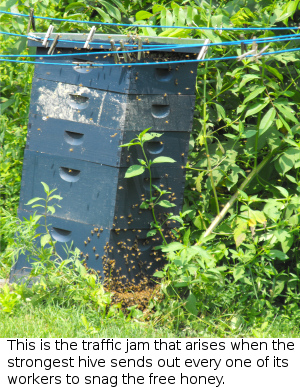 What
did I learn from this beginner mistake? First of all, I should
have propped the hive lids up with small sticks to accelerate air flow
as soon as I saw bees "bearding" (sitting on the side of the box and
fanning their wings.) I think I also should have left the supers
at ten frames per box for a week or so after
harvesting the honey so that the bees could firm back up the wax
damaged by the extraction process before filling it up with so much
honey.
What
did I learn from this beginner mistake? First of all, I should
have propped the hive lids up with small sticks to accelerate air flow
as soon as I saw bees "bearding" (sitting on the side of the box and
fanning their wings.) I think I also should have left the supers
at ten frames per box for a week or so after
harvesting the honey so that the bees could firm back up the wax
damaged by the extraction process before filling it up with so much
honey.
Finally, I definitely
should have checked on the hive a week or two after extraction.
I've read that collapses domino through the hive if left in place,
since the horizontal frames from the first collapse make the hive heat
up further. If I'd caught the collapse in its early stages,
chances are I could have prevented the large scale catastrophe.
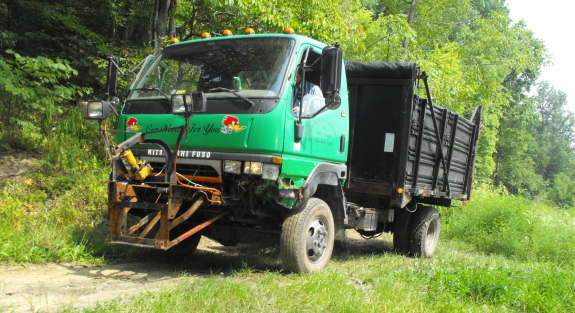
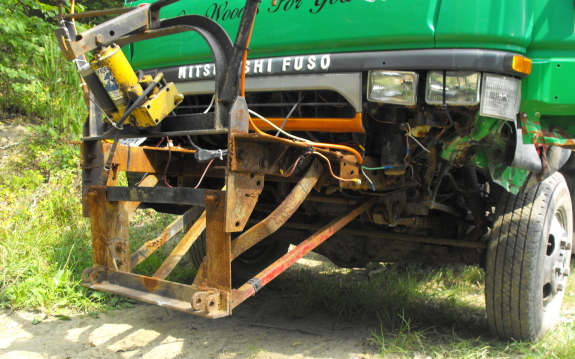
The BFR
Mulch guy called this
morning saying he could only deliver us 6 scoops of
compost instead of the 9
that was mentioned last week due to the dump mechanism not being able
to handle the extra weight.
I was thinking it was still a
good deal that would save me from making 3 round trips to Norton. Add
the travel time with the time to unload each load and it equals up to
somewhere over a day's worth of labor. The delivery charge was going to
be 75 dollars.
I was very clear on the phone
that I needed them to cross a creek and requested the 4 wheel drive
Mitsubishi Fuso dump truck by name.
They made it as far as our
ford when they had to
stop and give up. It seems like someone decided to add a snow plow
attachment that shrinks the clearance down to a paltry 8 or 10 inchs!
I can see how they would want
to take advantage of this 4 wheel drive beast in the winter by pushing
snow, but why not install it so that you could unbolt it for the
summer? It was welded on and the only obstacle to getting the load back
to our garden.
I almost had them dump the
load out by our parking area, but decided that would be even more work
loading back on the truck and then unloading it at the garden.
The driver was a nice guy and
apologetic about the handicapped truck.
"I guess most people don't
live this far back in the woods anymore these days?" I asked the guy
while we puzzled over the problem at the creek.
I felt bad about sending him
back with the full load, but even felt worse over the wasted morning
with nothing to show for it. This still seems to be a good option for
mulch and compost delivery, just don't expect them to go up any sort of
hill or over a big bump.
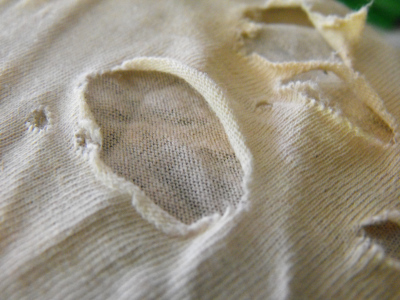 Half
of you are going to find this post ludicrously basic, but I suspect the
other half of you never learned the facts of life from your
mother. Paper towels seem to be the last bastion
of consumer society found in many homesteaders' households, but the
truth is that you already have a free alternative --- rags.
Half
of you are going to find this post ludicrously basic, but I suspect the
other half of you never learned the facts of life from your
mother. Paper towels seem to be the last bastion
of consumer society found in many homesteaders' households, but the
truth is that you already have a free alternative --- rags.
How
to make rags
The first step in making
rags is wearing your clothes into the ground. After a certain
point, there's no purpose in mending a piece of clothing --- the fabric
has degraded so much that it will merely rip along your mended
seam. Or maybe your t-shirt now has half a dozen holes that seem
to get bigger every day. Put it in the rag bag.
 Once
a year or so, I get around to pulling out the rag bag and taking a
look. First, I sort my old clothes into three piles --- 100%
cotton, partially synthetic, and fully synthetic or bulky. The
last category doesn't have much use on our homestead, so we tend to
relegate it to winter pet bedding, but all of the others will be
used. We turn 100% cotton clothes into fodder for my bees'
smoker, and everything else becomes rags. Underwear and t-shirts
make the best smoker fodder and rags, and luckily they're the pieces of
clothing that wear out the quickest.
Once
a year or so, I get around to pulling out the rag bag and taking a
look. First, I sort my old clothes into three piles --- 100%
cotton, partially synthetic, and fully synthetic or bulky. The
last category doesn't have much use on our homestead, so we tend to
relegate it to winter pet bedding, but all of the others will be
used. We turn 100% cotton clothes into fodder for my bees'
smoker, and everything else becomes rags. Underwear and t-shirts
make the best smoker fodder and rags, and luckily they're the pieces of
clothing that wear out the quickest.
Making rags is
simple. Just cut through any turned-under edges, then
riiiiiiiip. (Rag production is also a great way to improve your
mood if you're down in the dumps --- so satisfying.) It's best to
tear off and discard underwear waistbands and t-shirt collars, but
otherwise there are no rules. Just be sure to end up with rags
roughly eight inches by eight inches.
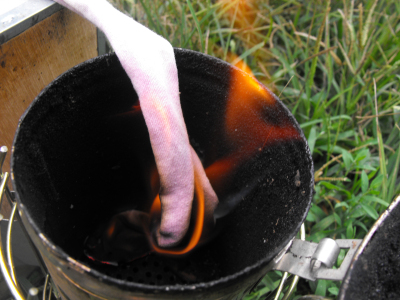 How to use rags
How to use rags
Now, how do you use
rags? The first line of defense in our household is the wash
cloth. These storebought items (costing perhaps a quarter apiece
at the dollar store) will last years as long as you use them for gentle
cleaning like doing dishes and wiping down counters. I only pull
out rags when I'm going to be working in more goopy or disgusting
situations, like wiping oil off a machine or cleaning up fecal matter.
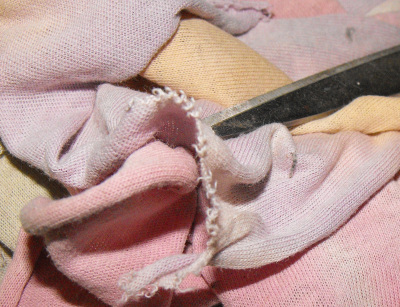 What do you do with a dirty
rag? If it's not too filthy, rinse it out in the sink, then drape
it over the side of the laundry basket to dry. Rags can then be
washed with your regular laundry. On the other hand, we reserve
the right to throw rags away if they're too awful --- that's why we use
them for the more disgusting tasks that would retire a wash cloth.
What do you do with a dirty
rag? If it's not too filthy, rinse it out in the sink, then drape
it over the side of the laundry basket to dry. Rags can then be
washed with your regular laundry. On the other hand, we reserve
the right to throw rags away if they're too awful --- that's why we use
them for the more disgusting tasks that would retire a wash cloth.
We tend to go through
rags at just about exactly the same rate we go through clothes.
You're probably discarding your clothing too soon and buying too much
of it if you're overrun with rags.
For those of you who
were raised using rags, I'm curious to hear what you'd add to my rag
tutorial. Any helpful tips for the uninitiated? Any uses
for those bulky blue jeans and fleece shirts?
 Youtube
user clintfisher has created what I would call the most
sophistitcated automatic chicken coop door opener I've seen so far.
Youtube
user clintfisher has created what I would call the most
sophistitcated automatic chicken coop door opener I've seen so far.
It uses Arduino technology
that allows for wireless control and will be powered by a solar cell
that charges a small 12 volt battery.
The locking mechanism is
impressive and he makes use of an old battery powered drill for the
motor action.
I doubt if there's any
racoons out there smart enough to get through this level of security.

Edited to add:
After years of research, Mark eventually settled on this automatic chicken door.
You can see
a summary of the best
chicken door alternatives and why he chose this version here.
If you're planning on
automating your coop, don't forget to pick up one of our chicken waterers. They never spill or
fill with poop, and if done right, can only need filling every few days
or weeks!
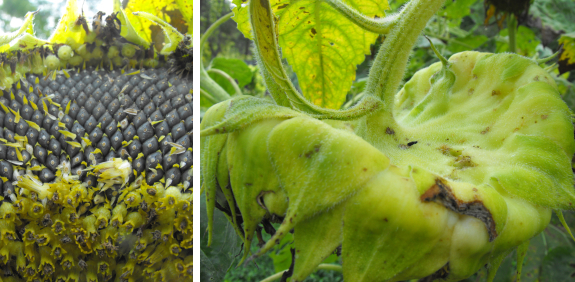
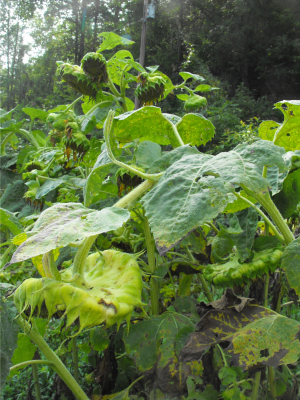 Last
year, oilseed
sunflowers were an
experimental crop for us, so of course the deer ate them and we didn't
have any seeds to harvest. Deer aren't so interested in the
sunflowers this year, preferring to nibble our experimental
beans, so I've been
thrilled to watch these low-work vegetables do their thing. The
plants quickly shot up above my head, opened huge yellow flowers, and
then dropped the petals as the seeds swelled up and the heads drooped
under their own weight.
Last
year, oilseed
sunflowers were an
experimental crop for us, so of course the deer ate them and we didn't
have any seeds to harvest. Deer aren't so interested in the
sunflowers this year, preferring to nibble our experimental
beans, so I've been
thrilled to watch these low-work vegetables do their thing. The
plants quickly shot up above my head, opened huge yellow flowers, and
then dropped the petals as the seeds swelled up and the heads drooped
under their own weight.
Some people advocate
leaving sunflowers to dry in the field, but I know for a fact that our
local wildlife would consider that a "free lunch" sign. So as
soon as the backs of the flower heads began to yellow and the tiny
yellow disc flowers in the center of the "flower" easily rubbed off the
black seeds, I snipped the tops off the sunflower stalks and hung them
to dry under the porch eaves.
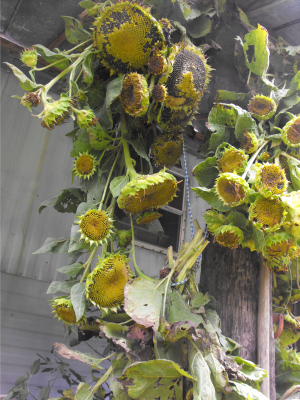 The
harvest came not a moment too soon. As I worked, a brilliant
yellow goldfinch flew to one of the headless stalks and chittered at
me. "Hey, no fair! I was counting on that to feed my
family!" A couple of hours later, he'd gathered his wife and
brothers to peck seeds out of the drying heads, so I had to cover the
whole mass with row cover fabric. I hope he isn't bright enough
to slip up underneath the fabric, but even so I'm considering rubbing
the seeds out of the heads ASAP and putting them in a sealed container.
The
harvest came not a moment too soon. As I worked, a brilliant
yellow goldfinch flew to one of the headless stalks and chittered at
me. "Hey, no fair! I was counting on that to feed my
family!" A couple of hours later, he'd gathered his wife and
brothers to peck seeds out of the drying heads, so I had to cover the
whole mass with row cover fabric. I hope he isn't bright enough
to slip up underneath the fabric, but even so I'm considering rubbing
the seeds out of the heads ASAP and putting them in a sealed container.
If I get my act together
and buy or make an oil press, I'll let you all know how much oil you
get out of two beds of sunflowers. Or maybe I'll just save them
and feed
the high protein sunflower seeds to the chickens.
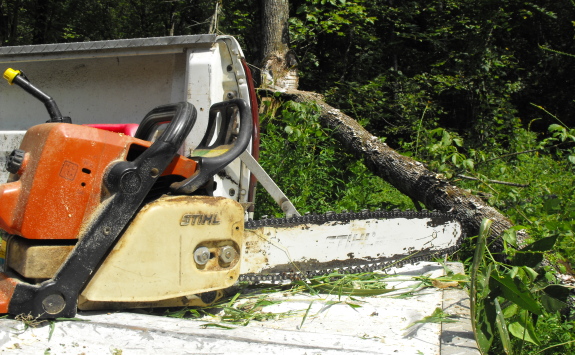
It would be great if all the
downed trees would fall like this one.
Being elevated off the ground
makes it so much easier to cut and avoid letting the chain dip into the
dirt, not to mention being safer.
I start at the far end and
just let each log fall to the ground, and then let Anna load them up in
the truck.
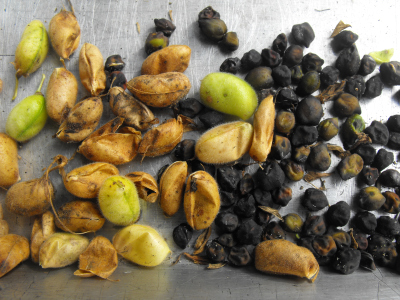 After
carefully
snipping butternuts off the vine and felling
towering sunflowers with a single blow, it was time to harvest our experimental
beans. First
came the garbanzos --- aren't they lovely? The only problem is
that what you see in this photo is nearly the entire harvest. I'm
not giving up on the variety, though, since a reader commented a few
months ago to let me know that the extremely confusing instructions on
the seed packet were really trying to tell me to plant
the garbanzos at the same time as peas. I planted them at the
frost free date instead, so I'll have to give the crop a more fair shot
next year.
After
carefully
snipping butternuts off the vine and felling
towering sunflowers with a single blow, it was time to harvest our experimental
beans. First
came the garbanzos --- aren't they lovely? The only problem is
that what you see in this photo is nearly the entire harvest. I'm
not giving up on the variety, though, since a reader commented a few
months ago to let me know that the extremely confusing instructions on
the seed packet were really trying to tell me to plant
the garbanzos at the same time as peas. I planted them at the
frost free date instead, so I'll have to give the crop a more fair shot
next year.
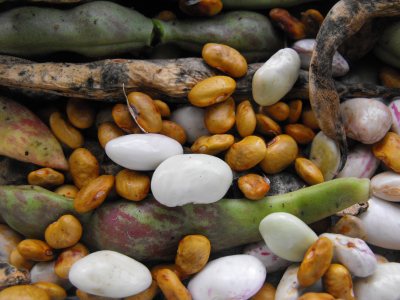 Next
stop "shelly beans", as folks around here like to call beans that you
grow for drying. The harvest in this bed was much better, despite
the fact that bean bugs ate the plants down to nubbins...then moved on
to my delightful Masai beans. I'm tempted to blame
the arrival of this new garden pest on the shelly beans, but I suspect
that it just took the beetles a few years to find us. Next year,
I'll add the Mexican Bean Beetle to my list of bad bugs to squash
weekly, and maybe all of our beans will do better.
Next
stop "shelly beans", as folks around here like to call beans that you
grow for drying. The harvest in this bed was much better, despite
the fact that bean bugs ate the plants down to nubbins...then moved on
to my delightful Masai beans. I'm tempted to blame
the arrival of this new garden pest on the shelly beans, but I suspect
that it just took the beetles a few years to find us. Next year,
I'll add the Mexican Bean Beetle to my list of bad bugs to squash
weekly, and maybe all of our beans will do better.
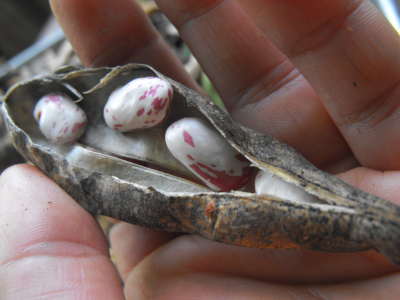 Although
the quantity of pods from the shelly bean bed was good, I discovered
that I should have picked the drying beans much sooner. Many
people leave beans for drying to harden on the plant, but our climate
is just too damp for that sort of harvest. By the time I picked
them, many of the older pods had begun to mold, and over half of the
beans were discolored. Next year, I'll harvest the beans when the
pods are still slightly green, then allow them to dry inside, out of the
weather.
Although
the quantity of pods from the shelly bean bed was good, I discovered
that I should have picked the drying beans much sooner. Many
people leave beans for drying to harden on the plant, but our climate
is just too damp for that sort of harvest. By the time I picked
them, many of the older pods had begun to mold, and over half of the
beans were discolored. Next year, I'll harvest the beans when the
pods are still slightly green, then allow them to dry inside, out of the
weather.
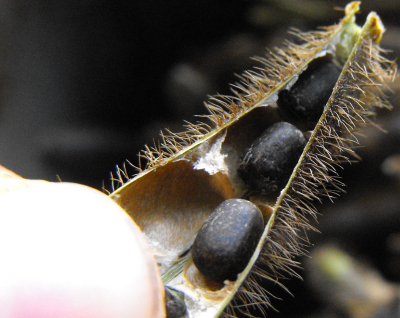 Finally,
I came to our Urd Beans (a variety of sprouting bean.) I thought
this bed was a goner after the deer nibbled it nearly down to the
ground...then repeated the maneuver a week later. But the Urd
Beans have a saving grace --- bean bugs don't like them. Despite
the name "Bean", Urd Beans are in an entirely different genus than Phaseolus
vulgaris (which
includes green beans and the green-bean-like shelling beans I
planted.) Instead, Urd Beans (Vigna
mungo) are in the
same genus as black-eyed peas, a group that seems to be of little
interest to our current crop pest.
Finally,
I came to our Urd Beans (a variety of sprouting bean.) I thought
this bed was a goner after the deer nibbled it nearly down to the
ground...then repeated the maneuver a week later. But the Urd
Beans have a saving grace --- bean bugs don't like them. Despite
the name "Bean", Urd Beans are in an entirely different genus than Phaseolus
vulgaris (which
includes green beans and the green-bean-like shelling beans I
planted.) Instead, Urd Beans (Vigna
mungo) are in the
same genus as black-eyed peas, a group that seems to be of little
interest to our current crop pest.
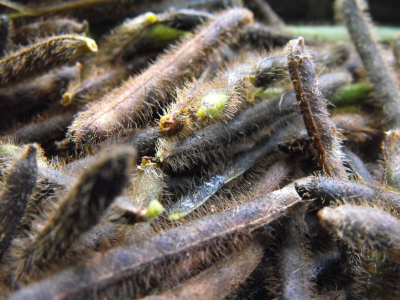 I
was also pleased to see that Urd Bean pods are hairy, a feature that
seems to repel moisture, keeping the seeds inside dry even after the
pods turn black. I harvested half of the pods, leaving the green
fruits on the vine to be picked at a later date. The only problem
I foresee with Urd Beans so far is their size --- shelling these little
guys by hand would take all day. (For a sense of scale, that's my
thumbnail on the left side of the first picture of urd beans.)
I'm hopeful, though, that after I let the pods dry for a week or two,
they'll be brittle enough that I can thresh them and then blow the
empty pods off the seeds.
I
was also pleased to see that Urd Bean pods are hairy, a feature that
seems to repel moisture, keeping the seeds inside dry even after the
pods turn black. I harvested half of the pods, leaving the green
fruits on the vine to be picked at a later date. The only problem
I foresee with Urd Beans so far is their size --- shelling these little
guys by hand would take all day. (For a sense of scale, that's my
thumbnail on the left side of the first picture of urd beans.)
I'm hopeful, though, that after I let the pods dry for a week or two,
they'll be brittle enough that I can thresh them and then blow the
empty pods off the seeds.
So, to sum up what
became far too long of a post --- garbanzos need to be planted in early
spring, shelly beans need to be harvested before the pods turn brown,
and Urd Beans are my new favorite experimental bean.

Saturday night in small town
America shot about an hour ago.
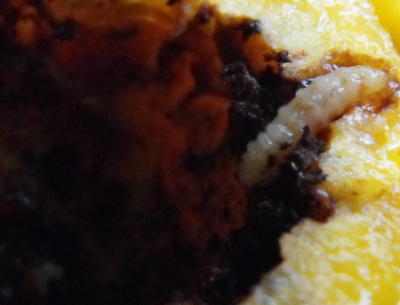 Our peach tree had another surprise
in store for me. I chomped down on one of its luscious
fruits...and spit that bite right back out, along with the maggot
happily consuming the peach's center. Yes, nearly every one of
our peaches has a little blob of gum on the outside marking the
entrance path of these little, white larvae.
Our peach tree had another surprise
in store for me. I chomped down on one of its luscious
fruits...and spit that bite right back out, along with the maggot
happily consuming the peach's center. Yes, nearly every one of
our peaches has a little blob of gum on the outside marking the
entrance path of these little, white larvae.
The first step in
combatting any insect infestation is figuring out
what you've got, but I had quite a time identifying my maggot. My
handy Garden Insects of North
America narrowed
down the 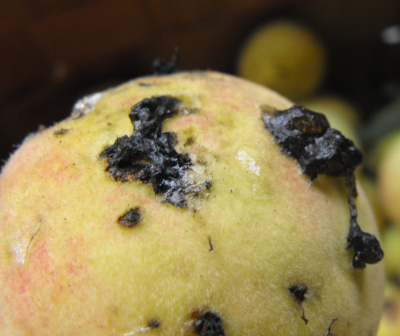 playing
field
to a mere score of "fruit chewers": plum curculio, plum gouger, cherry
curculio, speckled green fruit worm, peach twig borer, eyespotted bud
moth, oriental fruit moth, navel orangeworm, lesser appleworm, cherry
fruit-worm, mineola moth, cherry fruit sawfly, apple maggot, walnut
husk fly, cherry fruit fly, western cherry fruit fly, black cherry
fruit fly, chokecherry gall midge, European earwig, or green fruit
beetles.
playing
field
to a mere score of "fruit chewers": plum curculio, plum gouger, cherry
curculio, speckled green fruit worm, peach twig borer, eyespotted bud
moth, oriental fruit moth, navel orangeworm, lesser appleworm, cherry
fruit-worm, mineola moth, cherry fruit sawfly, apple maggot, walnut
husk fly, cherry fruit fly, western cherry fruit fly, black cherry
fruit fly, chokecherry gall midge, European earwig, or green fruit
beetles.
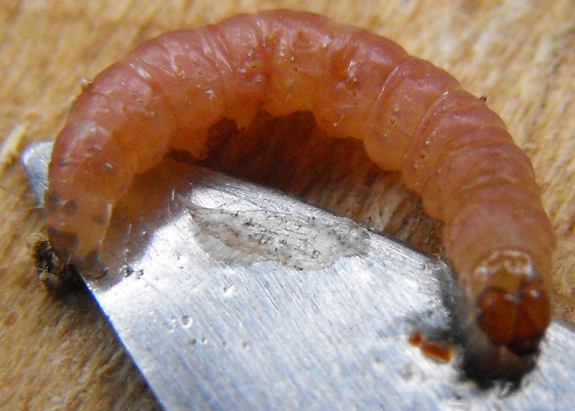
An expert at Bug Guide took a look and gave me a
tentative ID of
coddling moth or oriental fruit moth, the latter of which is more
likely as a pest of peaches. Although most of the mainstream
websites tell me to spray chemicals on my tree, an Australian
site
recommends running chickens in the orchard. I wonder if putting
up a temporary fence around our peach trees and running chickens inside
during critical periods in the spring and fall would be sufficient to
cut down on our peach damage?
That Australian site
(which I am thoroughly impressed by) also suggested some other
permaculture style control measures for the oriental fruit moth. My
favorite involves taking advantage of the fact that the moth goes
through several generations in a year. Before the fruit are
large, the larvae instead grow inside twigs, which are highly visible
because they wilt and produce gum. By cutting off and destroying
these infested twigs in the spring, you 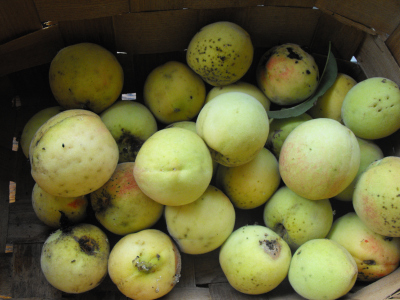 can
cut back the population, which means there won't be adults present to
lay eggs on your precious peaches.
can
cut back the population, which means there won't be adults present to
lay eggs on your precious peaches.
A final method of
control involves putting out artificial pheremones around the
tree. These pheremones mimic the scent emitted by the female moth
when she's trying to attract a mate, so they disrupt the moths' mating
behavior. At four pheremone ties per tree, replaced twice a year,
though, this method could add up.
Despite the problematic
centers, our white peaches are growing on
me. I cut them in half and scoop out the bad spots, then gulp
down half a dozen a day. Now that they're at their peak of
ripeness, I've discovered I prefer homegrown white peaches to
storebought yellow peaches!
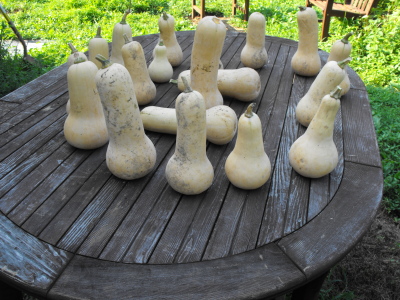
I managed to supplement our butternut
squash supply by about 35 various sized beauties grown by a friend
of mine for the grand total of 20 dollars.
I also talked him out of this
nice cedar table for an extra 50 bucks.
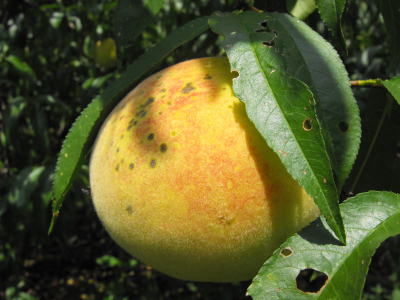 Step
1: Call up Mom.
There's a knack to cutting up wormy fruit, and chances are your
maternal helper will make the work go three times as fast. Bribe
her with less wormy peaches and other garden produce.
Step
1: Call up Mom.
There's a knack to cutting up wormy fruit, and chances are your
maternal helper will make the work go three times as fast. Bribe
her with less wormy peaches and other garden produce.
Step
2: Prepare the peaches.
Unless you bought your peaches from a commerical orchard, chances are
they need some bad spots cut out. Our peaches are the worst case
scenario since our oriental
fruit moth infestation
means that over half the fruits had rotten,
wormy centers. The quick and easy way to deal with troubled fruit
is to cut them in half and scoop out the rotten centers with a
spoon. Slice off the skin last in this case, or first if your
peaches are pristine.
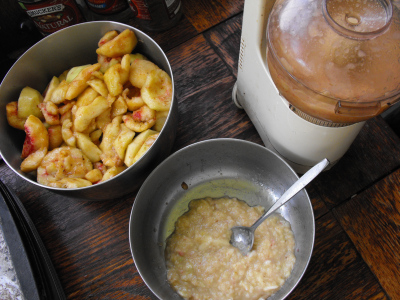 Step 3: Puree the raw peaches in a
food processor.
Step 3: Puree the raw peaches in a
food processor.
Step
4: Add honey to
taste. Honey gives the finished leather pliancy and helps
preserve the peach puree as
it dries. We added almost a cup of honey to about a gallon of
fruit puree --- use your own judgement here.
Step
5: Pour the puree and honey
mixture onto cookie sheets. The official method of
making
fruit leather involves spreading your puree on skins of saran wrap, but
we don't 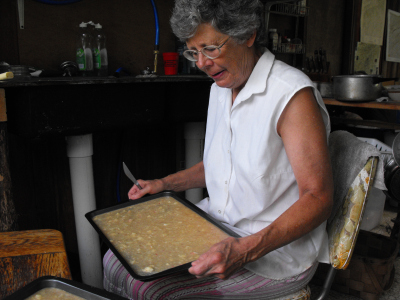 keep that kind of disposable
in the house. Cookie sheets
work fine as long as you don't mind your finished leather
getting bent
out of shape for storage.
keep that kind of disposable
in the house. Cookie sheets
work fine as long as you don't mind your finished leather
getting bent
out of shape for storage.
Step
6: Spread the puree to about 1/8
inch thick.
At first, we tried spreading the peach mush
with spoons and butter knives, then Mom had the great idea of just
jiggling the pan. The moist peach mixture quickly settled out
across the entire surface.
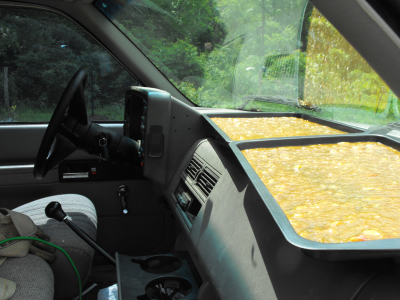 Step 7: Dry the fruit leather as quickly as
possible.
We haven't built our solar
dehydrator yet, so
last time I dried our fruit leather by moving it between our
east-facing sunny window (in the morning) and our west-facing sunny
window (in the afternoon.) Mom had the great idea of drying the
leather inside Joey's truck, which seems to be working even
better. You need hot temperatures around 100 F or higher to dry
the leather before it ferments and molds. Maximum drying time
should not exceed two and a half days.
Step 7: Dry the fruit leather as quickly as
possible.
We haven't built our solar
dehydrator yet, so
last time I dried our fruit leather by moving it between our
east-facing sunny window (in the morning) and our west-facing sunny
window (in the afternoon.) Mom had the great idea of drying the
leather inside Joey's truck, which seems to be working even
better. You need hot temperatures around 100 F or higher to dry
the leather before it ferments and molds. Maximum drying time
should not exceed two and a half days.
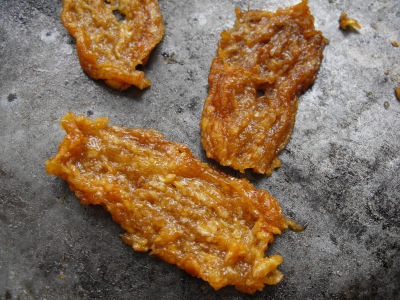 Step 8: Scrape the fruit leather off
the trays with a spatula. Depending on how much
moisture is left in your leather, it may peel off, or rumple up as
shown in my
pictures. I prefer the slightly wetter leather even though it's
less pretty.
Step 8: Scrape the fruit leather off
the trays with a spatula. Depending on how much
moisture is left in your leather, it may peel off, or rumple up as
shown in my
pictures. I prefer the slightly wetter leather even though it's
less pretty.
Step
9: Store your peach leather.
Fruit leather will last at room temperature for about a month, but I'm
planning to use the peaches as a supplement to our winter fruit.
In the freezer, fruit leather should last about a year.
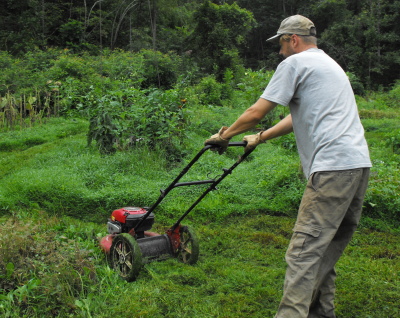
The bad thing about procrastinating on mowing is once the "lawn" gets
so high I can't run the mulch machine with the bag due to it bogging
down.
It's much more powerful once
you take the bag attachment off, but still has its limits.
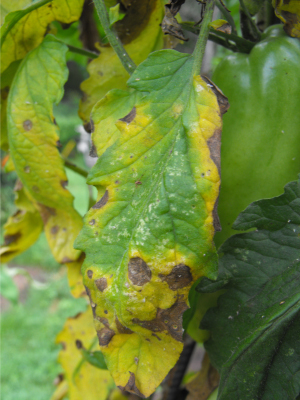 The
good news is that closer inspection of our tomatoes shows they are
infected with early blight, not late blight. Notice the yellowing
of the leaves and (not pictured) the absence of problems on the stems
and fruits. Although both are fungal diseases, early blight tends
to be less devastating, and I'm having very good luck keeping the
fungus in check with my
blight control measures.
The
good news is that closer inspection of our tomatoes shows they are
infected with early blight, not late blight. Notice the yellowing
of the leaves and (not pictured) the absence of problems on the stems
and fruits. Although both are fungal diseases, early blight tends
to be less devastating, and I'm having very good luck keeping the
fungus in check with my
blight control measures.
The bad news is that
early blight tends to stick around after it shows up. Unlike late
blight, which needs living tissue to survive, early blight can
overwinter in plant debris or even in saved seeds. Although it
pains me to remove biomass from the farm, we'll continue to take our
blighted leaves to the dump.
This week, I ripped out
another three tomato plants that showed too much damage to save.
But I can't complain, since the tomatoes have been pouring in.
Here's our August 6 harvest:
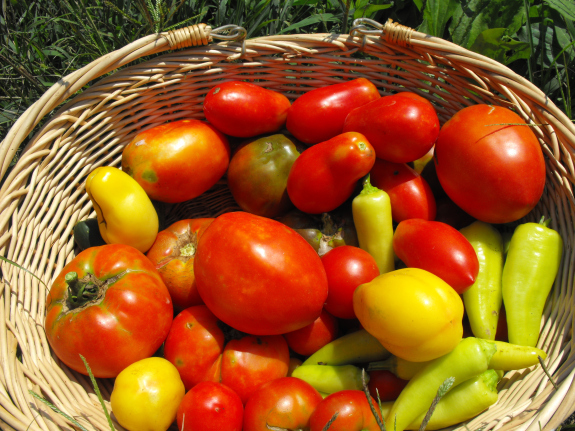
Then skip ahead a few
days to August 10, and you'll notice I had to upgrade to the bigger
basket:
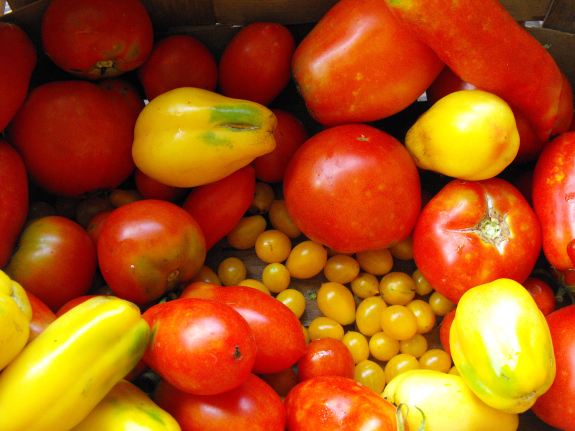
No photos of the next
few harvests, but suffice it to say that I'm now harvesting large
masses of tomatoes three times a week. We've already frozen a
gallon of pizza sauce and three quarts each of spaghetti sauce and
tomato-based vegetable soup. When the peach
leather comes out of
the automotive dehydrator today, I plan to replace the fruit with a
batch of sun-dried tomatoes.
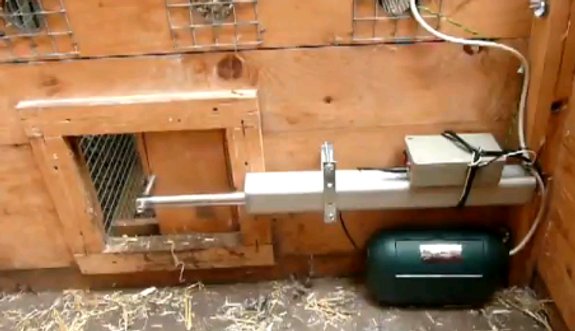
sk1ppy14 from somewhere in
the United Kingdom has done a fine job fabricating this automatic
chicken coop door closer/opener from an old gate opener.
These medium sized gate
openers will sometimes get weak over years of heavy usage and require
replacement. What a great way to extend the usefulness of this farm
gadget.

Edited to add:
After years of research, Mark eventually settled on this automatic chicken door.
You can see
a summary of the best
chicken door alternatives and why he chose this version here.
If you're planning on
automating your coop, don't forget to pick up one of our chicken waterers. They never spill or
fill with poop, and if done right, can only need filling every few days
or weeks!

We still think that plug
and play is the way
to go for our cheap
solar backup, but
we've tweaked the specific components a
bit. We wanted to find a powerpack that we could pick up at a
physical store since powerpacks bought online have often been stored in
warehouses for years and have dubious longevity. We figure that
by picking one up locally, we can easily return it if it turns out to
be old.
 The
5-in-1 power pack at Harbor Freight is the best we
could find at a physical store --- it's only two thirds as voluminous
as the Duracell 600 watt power pack, holding 216 watt-hours of energy,
but the price commensurate. And the reviews are quite good ---
one user notes that his powerpack is only starting to lose its gumption
after five years of use.
The
5-in-1 power pack at Harbor Freight is the best we
could find at a physical store --- it's only two thirds as voluminous
as the Duracell 600 watt power pack, holding 216 watt-hours of energy,
but the price commensurate. And the reviews are quite good ---
one user notes that his powerpack is only starting to lose its gumption
after five years of use.
The 45 watt solar panel kit is really too big for our system, but it's
irresistible at the current sale price ($170 on Harbor Freight's
website --- print out the price page to use as a coupon at local
stores.) Since we've oversized our solar panel, we have to throw
in a $26 charge controller, bringing the total cost to just under $300
for the entire backup system.
On a sunny, summer day, our 45 watt solar panel will probably be
wasting quite a bit of juice, since it should pull in 135 watt-hours of
energy a day even in the dead of winter. I suspect that there
will be a way to capture that excess, perhaps by plugging an inverter
directly into the included power center to run electronics while also
charging the powerpack. Or, better yet, we might buy a (roughly)
$100 grid tie inverter, which would allow us to plug our solar panel
directly into an electric socket in the house and sell power back to
the grid --- no muss, no fuss, and easily detachable to plug the solar
panel into an inverter when the power goes out.
We'll update you as we experiment, but Mark is currently on his way to
pick up our components, so this phase of the project is now set in
stone.

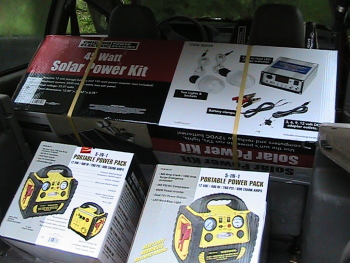 Harbor
Freight in Johnson City is an awesome store!
Harbor
Freight in Johnson City is an awesome store!
The manager was in a good
mood and gave us the additional 2 year warranty on each solar power kit
along with the portable power packs.
Stay tuned for more details
as I unbox and set up this new
technology.
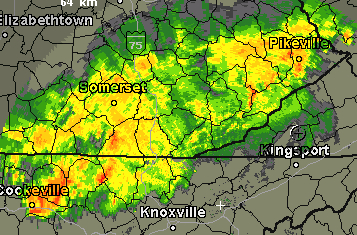 Wednesday
morning, the doppler radar looked like this. We'd had 5 inches of
rain already in the past week, the alligator swamp was filling back up,
and the main creek was once more creating a waterfall off the edge of
the ford. Clearly, our three week dry season had come to an abrupt end.
Wednesday
morning, the doppler radar looked like this. We'd had 5 inches of
rain already in the past week, the alligator swamp was filling back up,
and the main creek was once more creating a waterfall off the edge of
the ford. Clearly, our three week dry season had come to an abrupt end.
At times like this, I
feel like I'm always a step or two behind the weather, scurrying to
catch up. I'd just gotten into the swing of drying
fruit without a dehydrator and would have liked to
continue my success with tomatoes. I also had another 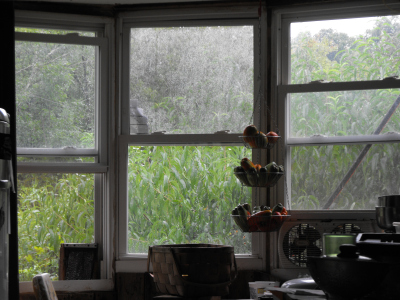 week's
worth of hauling on Mark's agenda. But the weather has mandated
that we shift gears, so we will --- on to weeding and mowing, planting
the last of the fall crops, and maybe finally finishing the shed.
week's
worth of hauling on Mark's agenda. But the weather has mandated
that we shift gears, so we will --- on to weeding and mowing, planting
the last of the fall crops, and maybe finally finishing the shed.
To be fair, drippy
summer afternoons when I'm just barely chilled in a t-shirt and shorts
are probably on my top ten list of favorite times. The rain
encloses me in a cocoon of gray noise and my mind becomes so clear I
can feel deep thoughts gelling in the corners.
 I
wrote about the resumption
of rainy weather
yesterday afternoon, after Mark drove Joey's truck out to leave it
across the creek and out of harm's way. It seems like we made the
right call. Rain pounded on the roof all night, bringing our
week's total up over 7 inches. By the time I walked Lucy, the
creek had risen from my ankle to my knee.
I
wrote about the resumption
of rainy weather
yesterday afternoon, after Mark drove Joey's truck out to leave it
across the creek and out of harm's way. It seems like we made the
right call. Rain pounded on the roof all night, bringing our
week's total up over 7 inches. By the time I walked Lucy, the
creek had risen from my ankle to my knee.
 I
dawdled a bit more than I should have since I knew from the doppler
radar that I only had about twenty minutes between cloudbursts.
But how could I resist trying to capture fog between the hills or a box
turtle catching a huge leech right along the edge of the public
road? My dawdling was worthwhile --- two trucks of tree
trimmers/chippers rolled by and I flagged them down to ask if they
would dump some wood chips in our parking area. They agreed
(although they've agreed before, and no wood chips have shown up), so I
scurried around to move our vehicles out of the way and give them a
place to dump my biomass.
I
dawdled a bit more than I should have since I knew from the doppler
radar that I only had about twenty minutes between cloudbursts.
But how could I resist trying to capture fog between the hills or a box
turtle catching a huge leech right along the edge of the public
road? My dawdling was worthwhile --- two trucks of tree
trimmers/chippers rolled by and I flagged them down to ask if they
would dump some wood chips in our parking area. They agreed
(although they've agreed before, and no wood chips have shown up), so I
scurried around to move our vehicles out of the way and give them a
place to dump my biomass.
Now an hour had passed
and the rain was pouring down. The muddy creek had risen past the
middle of my thigh, and at the rate the rain is still falling, I
suspect we may attain flood conditions today. I love the
neverending excitement on our farm!
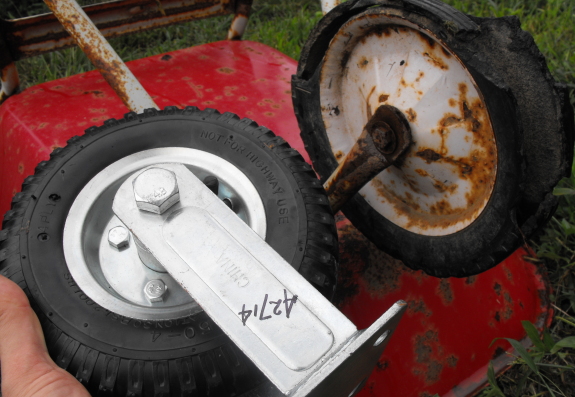
I've been looking everywhere
for a replacement wheel for this small wheelbarrow.
A bit of browsing at the Harbor
Freight store yesterday
lead me to this pneumatic wheel with heavy duty bracket for just 10
dollars.
Stay tuned for more pictures
of the installation process.
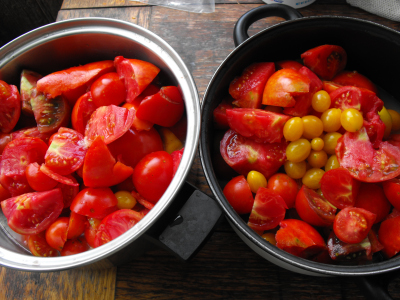 When
I was a junior in college, I spent my first summer away from home with
no cafeteria. In preparation, I
picked my father's brain for instructions on making my favorite
vegetable soup, pinning him
down on a specific number of onions, potatoes, tomatoes, and
more. But
it was a struggle to turn Daddy's words into a recipe, because that
wasn't the information he was trying to impart. Over a decade
later, I've finally figured out what my wise father was saying.
Yes,
I am a slow learner.
When
I was a junior in college, I spent my first summer away from home with
no cafeteria. In preparation, I
picked my father's brain for instructions on making my favorite
vegetable soup, pinning him
down on a specific number of onions, potatoes, tomatoes, and
more. But
it was a struggle to turn Daddy's words into a recipe, because that
wasn't the information he was trying to impart. Over a decade
later, I've finally figured out what my wise father was saying.
Yes,
I am a slow learner.
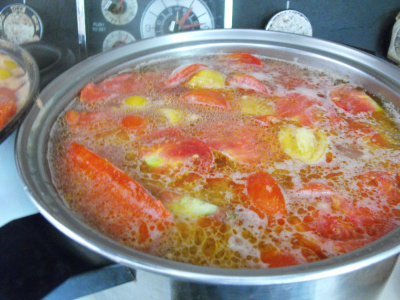 Daddy
was teaching me the trick of cooking in season with the easiest
in-season recipe --- harvest catch-all soup. He was trying to get
through my thick noggin the notion that meals should begin in the
garden with what's fresh and numerous, rather than with a detailed
shopping list at the grocery store. Clearly, this soup had been
his mother's way of using up odds and ends --- bits of browned carrots,
wilted greens, anything that wasn't rotten but wasn't prime enough for
being served plain. And, in essence, the soup was simple --- make
a stock, then throw in whatever vegetables you have lying around.
Daddy
was teaching me the trick of cooking in season with the easiest
in-season recipe --- harvest catch-all soup. He was trying to get
through my thick noggin the notion that meals should begin in the
garden with what's fresh and numerous, rather than with a detailed
shopping list at the grocery store. Clearly, this soup had been
his mother's way of using up odds and ends --- bits of browned carrots,
wilted greens, anything that wasn't rotten but wasn't prime enough for
being served plain. And, in essence, the soup was simple --- make
a stock, then throw in whatever vegetables you have lying around.
 The
first step was to make a soup base. Daddy's method involves one
onion, some garlic, and a cup and a half of cabbage all sauteed in a
bit of oil,
then simmered for a couple of hours with two stalks of celery, an 18
ounce can of tomatoes, and enough water to fill up the pot. My
method (at the moment, and ever evolving) starts with three quarters of
a pot of halved tomatoes, enough chicken stock to submerge the fruits,
two onions, six big cloves of garlic (minced), a big
handful of parsley (chopped), and about half a cup of dry beans
(pre-soaked.) This is the part of the soup where you'll want to
follow a vague recipe, but you'll notice that parsley is a great
substitute for the much harder to grow celery, and that if you start
with stock you don't need to bother with the sauteeing step. This
is also where you can tweak the flavor to suit your particular tastes.
The
first step was to make a soup base. Daddy's method involves one
onion, some garlic, and a cup and a half of cabbage all sauteed in a
bit of oil,
then simmered for a couple of hours with two stalks of celery, an 18
ounce can of tomatoes, and enough water to fill up the pot. My
method (at the moment, and ever evolving) starts with three quarters of
a pot of halved tomatoes, enough chicken stock to submerge the fruits,
two onions, six big cloves of garlic (minced), a big
handful of parsley (chopped), and about half a cup of dry beans
(pre-soaked.) This is the part of the soup where you'll want to
follow a vague recipe, but you'll notice that parsley is a great
substitute for the much harder to grow celery, and that if you start
with stock you don't need to bother with the sauteeing step. This
is also where you can tweak the flavor to suit your particular tastes.
 After
simmering the soup base for two or more hours until it has halved in
volume, you can pretty
much throw in whatever you want --- preferably whatever's in season
that you're sick and tired of freezing. Vegetables will cook in a
bubbling pot of soup stock at about the same rate as they cook in a pot
of boiling water, so add the veggies a minute before you eat
(for sweet corn), ten minutes before you eat (for beans, okra, summer
squash, etc.), or forty-five minutes before you eat (for
potatoes.) You can make the soup into a stew like Daddy's, chock
full of so many vegetables that it should be eaten on a plate, or you
can keep your soup more Cambell's-like and just add in perhaps a quart
of vegetables in the final step.
After
simmering the soup base for two or more hours until it has halved in
volume, you can pretty
much throw in whatever you want --- preferably whatever's in season
that you're sick and tired of freezing. Vegetables will cook in a
bubbling pot of soup stock at about the same rate as they cook in a pot
of boiling water, so add the veggies a minute before you eat
(for sweet corn), ten minutes before you eat (for beans, okra, summer
squash, etc.), or forty-five minutes before you eat (for
potatoes.) You can make the soup into a stew like Daddy's, chock
full of so many vegetables that it should be eaten on a plate, or you
can keep your soup more Cambell's-like and just add in perhaps a quart
of vegetables in the final step.
Daddy concluded his
lesson with these words of wisdom: "Use a big pot. Your soup
will expand to fill the space provide." Nowadays, I make two pots
of soup at once during harvest time, the better to concentrate summer
goodness for winter delight.
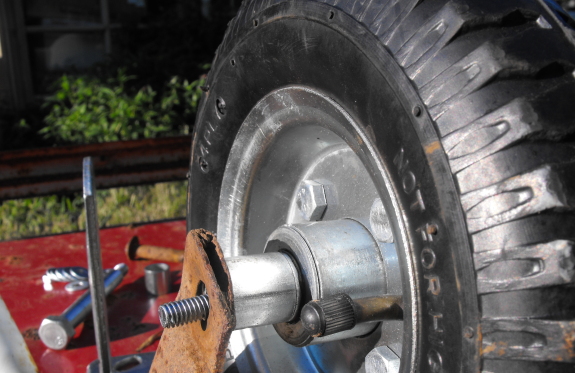
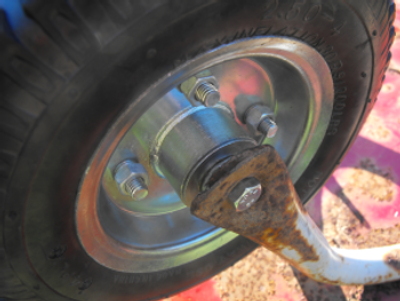
The old wheel shaft rust was holding hard and required cutting.
The
Harbor Freight tire was a tight squeeze with the spacer and washers.
I used a slightly smaller
bolt to avoid making the holes on the wheel holder bigger.
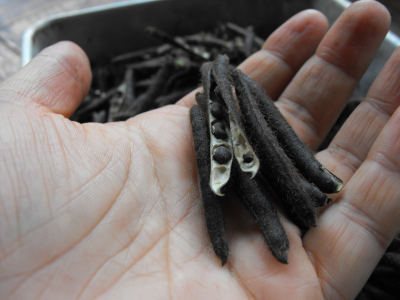 Last
week, I wrote that I
was concerned shelling tiny Urd Beans might be difficult. I needn't have
worried. A few days later, when hot sunlight was streaming in the
front window and across my pan of drying beans, I was startled by a
loud pop. "Huckleberry!" I exclaimed, sure that our spoiled cat
had gotten into something he shouldn't have, but Huckleberry was asleep
on the couch and the popping continued.
Last
week, I wrote that I
was concerned shelling tiny Urd Beans might be difficult. I needn't have
worried. A few days later, when hot sunlight was streaming in the
front window and across my pan of drying beans, I was startled by a
loud pop. "Huckleberry!" I exclaimed, sure that our spoiled cat
had gotten into something he shouldn't have, but Huckleberry was asleep
on the couch and the popping continued.
I eventually figured out
what every Urd Bean grower out there already knows --- warm, dry
weather will shell your Urd Beans for you. When the pods reach a
certain level of dryness, the two halves curl apart and the seeds
explode out in every direction. Picking 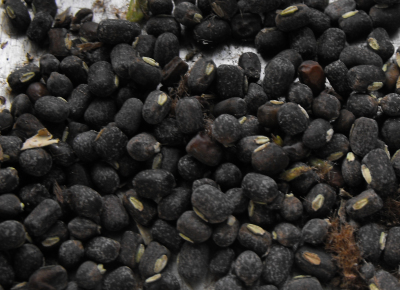 another batch of pods this
week, I had to carefully enclose entire fruits in my hand since even
the gentle pressure of my fingers was enough to pop some pods open,
just like pressing on a touch-me-not pod.
another batch of pods this
week, I had to carefully enclose entire fruits in my hand since even
the gentle pressure of my fingers was enough to pop some pods open,
just like pressing on a touch-me-not pod.
Green or damp pods don't
pop on their own, but if you catch them during a dry day, you can
gently roll a handful between your palms and remove the hulls from
several pods at once. Or just wait until the sun comes out and
your kitchen turns into a rice krispies commercial --- snap, crackle,
pop.
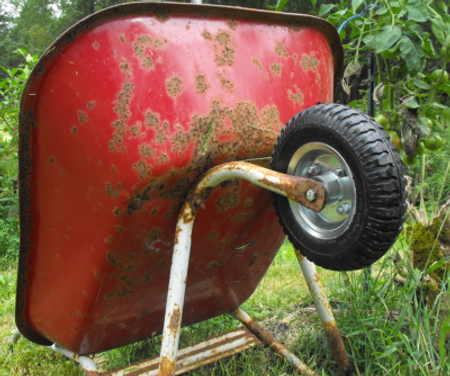 The
only thing the new
wheel needs is a locking nut, which will have to wait for the next
town trip.
The
only thing the new
wheel needs is a locking nut, which will have to wait for the next
town trip.
I know the body is rusted and
has holes, but this repair gives me a warm fuzzy feeling that a new
wheelbarrow could never deliver.
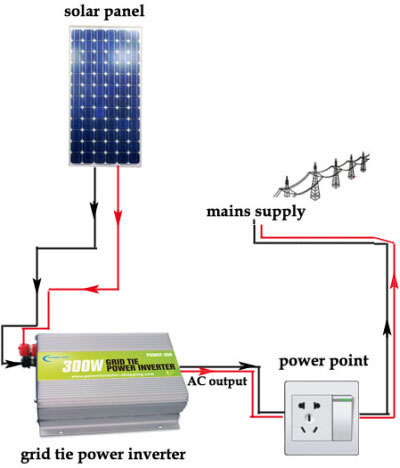 I
got so excited when I read that you can buy a plug-and-play grid tie
inverter and pump the electricity from your solar panel directly into
the grid for less than a hundred bucks that I snatched up the first one
I saw on ebay. The theory is sound and would make small-scale
solar fit into the average person's price range...if it wasn't illegal
and potentially hazardous.
I
got so excited when I read that you can buy a plug-and-play grid tie
inverter and pump the electricity from your solar panel directly into
the grid for less than a hundred bucks that I snatched up the first one
I saw on ebay. The theory is sound and would make small-scale
solar fit into the average person's price range...if it wasn't illegal
and potentially hazardous.
The dream is that you
can simply plug a solar panel directly into one of these small
inverters, and plug the other end of the inverter into an electric
socket in your house. On the level I'm interested in, there's no
way you'd actually be feeding energy back into the grid since
continuous loads in your house (like the computer, fridge, etc.) will
suck up all the juice you've created. But you would lower your
electric bill, and would also remove the most disposable part of a
solar power system --- the batteries. Without the repeated
purchase of batteries, I
figured even the solar panels you can buy at Harbor Freight for less
than $200 would pay for themselves before they began to
seriously lose efficiency.
The problem with the
dream is that utilities require you to jump through such a series of
hoops before tying into the grid that you might as well not even think
about it unless you're willing to sink a few thousand dollars into the
project. I contacted our local electric company (Appalachian
Electric Power) and found out that in order to plug in a grid tie
inverter, we'd need to:
The employee I emailed
with (who went to great lengths to make his emails understandable by
the layman) explained that the existing disconnect below the meter is
not sufficient to fulfill step 3. In addition, more extensive
reading on the internet shows that a certified inverter costs around
$2,000, putting grid tie-in completely out of our league.
 The
electric company has a few valid reason to squash cheap plug-and-play
inverters. The biggest hazard from these inverters comes during
power outages, when the electric company shuts down the juice on a line
so that it can be repaired. Without the proper precautions, your
solar panels would continue feeding electricity into what is supposed
to be a dead line, and you could fry the linemen who come to fix the
problem. Granted, even the cheap power jack grid tie inverter we
found on ebay has anti-islanding protection, so presumably this problem
wouldn't occur.
The
electric company has a few valid reason to squash cheap plug-and-play
inverters. The biggest hazard from these inverters comes during
power outages, when the electric company shuts down the juice on a line
so that it can be repaired. Without the proper precautions, your
solar panels would continue feeding electricity into what is supposed
to be a dead line, and you could fry the linemen who come to fix the
problem. Granted, even the cheap power jack grid tie inverter we
found on ebay has anti-islanding protection, so presumably this problem
wouldn't occur.
I read an excellent
point on a forum that our grid tie inverter is inherently unsafe since
it has live electricity on the male end of the plug rather than
protected within a female plug. This is where my (very mild)
libertarian leanings come out --- we live in a household of two adults
who can remember to unplug the solar panel before yanking the inverter
out of the wall. We're not going to fry ourselves.
Many people buy these
plug-and-play grid tie inverters and surreptitiously put them to use in
their own homes. Chances are, no one at the electric company
would ever find out (although if you go the illegal route and have a
fire in your home, your fire insurance will probably refuse to pay for
the damages.) Unfortunately, breaking the law would keep me up at
night, so we've wasted $90 on a useless grid tie inverter and will have
to figure out a better way to harness the extra energy that doesn't go
into charging
our power packs.
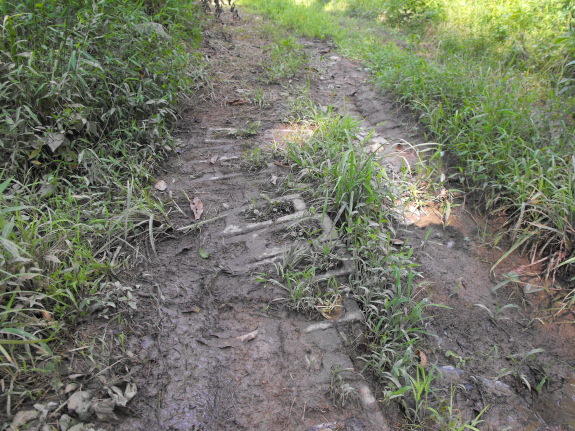
You can barely make out where
the left rut here has several cinder blocks laid next to each other in
an attempt to harden up an area that sometimes has running water
passing through.
It's been over 4 years now
and the cinder block mini ford has proven itself to be a long term
workable replacement to big gravel, which has a tendency to spread out
and sink even deeper under these conditions.
The only problem was a 20
degree tilt over time as heavy trucks and golf carts weighed heavily on
its outer edge. I think the angle might even help some of the tires
grip easier in wet conditions, but it's never been a problem.
 Yes,
the pictures don't lie --- I've been planting grass in our
garden. Perhaps an eighth of our garden beds are currently
fallow, partly because I didn't water carefully enough and had a hard
time getting my fall
crops to
germinate. As August winds to a close, it's too late to replant
the turnips, cabbage, beets, and carrots that had spotty (or no)
germination. Instead, I can double up on greens and lettuce, plan
ahead for the fall garlic, and then fill all of the remaining beds with
cover crops to improve the soil.
Yes,
the pictures don't lie --- I've been planting grass in our
garden. Perhaps an eighth of our garden beds are currently
fallow, partly because I didn't water carefully enough and had a hard
time getting my fall
crops to
germinate. As August winds to a close, it's too late to replant
the turnips, cabbage, beets, and carrots that had spotty (or no)
germination. Instead, I can double up on greens and lettuce, plan
ahead for the fall garlic, and then fill all of the remaining beds with
cover crops to improve the soil.
As you'll recall, buckwheat has
been relegated to my list of cover crops that can't handle heavy clay
and high groundwater
--- the precise type of trouble spot I want to remedy with cover crop
planting. The next cover crop on my experimental list is oats,
and already this grain seems to be growing much more hardily than
buckwheat. Hopefully, the oats will be winter-killed in a couple
of months and will leave the beds happily mulched with straw of their
own making.
I had some hull-less
oat seeds leftover,
but not nearly enough to sow all of the beds I was hoping to turn
fallow for the rest of the summer. After looking at shipping
rates on the internet, I realized that cover crop seeds are best bought
locally. Our feed store had a 50 pound bag for about twelve
bucks, allowing me to plant as heavily as I pleased with plenty of the moderately
high protein grain
left to feed to the chickens.
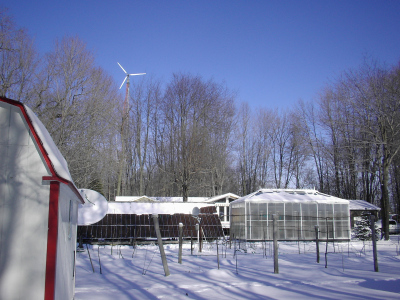 Since
our own solar
experiments are so
low-key at the moment, I thought you
might enjoy hearing from one of our regular readers who has built an extensive grid tied solar and wind alternative power system. Zimmy and his wife live in a 1974 mobile
home (14 X 60 feet):
Since
our own solar
experiments are so
low-key at the moment, I thought you
might enjoy hearing from one of our regular readers who has built an extensive grid tied solar and wind alternative power system. Zimmy and his wife live in a 1974 mobile
home (14 X 60 feet):
 I was intrigued to hear more about Zimmy's
project since we live in a
similar trailer (although ours is a third smaller and a decade
older.) We thoroughly approve of starting out with a living
situation that is as cheap as possible, then improving the efficiency
of your space over time.
I was intrigued to hear more about Zimmy's
project since we live in a
similar trailer (although ours is a third smaller and a decade
older.) We thoroughly approve of starting out with a living
situation that is as cheap as possible, then improving the efficiency
of your space over time.
Mobile homes are usually
barely insulated, but Zimmy proved that you
can turn even an old model into an efficient and beautiful living
space. This week's lunchtime series follow's Zimmy's journey to
insulate his home and then provide a good proportion of his own power.
| This post is part of our Energy Efficient Mobile Home lunchtime
series.
Read all of the entries: |


Have you ever wondered how far out your pet roams during the day and at
night?
Thanks to a cat named Mr Lee it is
now possible to track your animal on a plug and play level.
The low end gizmo records up
to 30 hours of prowling and needs to be downloaded via USB cable. 44
dollars.
The high end version transmits live data through GMS cel phone
technology.
125 dollars.
Both interface with Google
maps and claim to be easy to use.
I could see this being handy
for goats and sheep or just about any level of livestock bigger than a
chicken.
It would be interesting to
see where Lucy spends her time, but I predict Huckleberry's map would
only consist of him going from the couch to the chair to his basket
with multiple trips to his food dish.
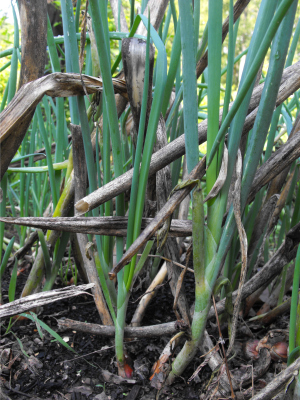 Several
people have asked me, "Do I have to pull up my Egyptian onions and replant them every
year?" I'm not surprised that they ask --- even though Egyptian
onions are perennials, the tops die back for about a month at the peak
of summer and the plants look a bit dead. But as August draws to
a close, new green shoots poke up from the bulbs, proving that the
onions are still very much alive.
Several
people have asked me, "Do I have to pull up my Egyptian onions and replant them every
year?" I'm not surprised that they ask --- even though Egyptian
onions are perennials, the tops die back for about a month at the peak
of summer and the plants look a bit dead. But as August draws to
a close, new green shoots poke up from the bulbs, proving that the
onions are still very much alive.
In the past, I've yanked
out the bottom bulbs during the dormant month and replanted top bulbs
in new beds. But the bottom bulbs don't rot in the compost pile,
so I ended up with a lot of onions. This year,
I'm letting the Egyptian onion beds alone to see if I can treat them
like true perennials. The only problem I foresee is overcrowding
--- each bottom bulb has now split into several new bulbs. Since
I yank whole plants now and then to make Butternut Squash and
Egyptian Onion Soup,
hopefully this overcrowding won't be an issue.
As a final note, we sold
all but about a hundred of our onions, and I saved the last ones for a
quick giveaway. Just leave a comment on this post before August
29 and I'll choose one lucky winner at random to receive the last of
our onion top bulbs.
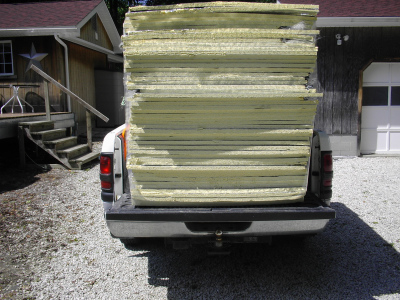 Adding
a roof and basement to his mobile home
made it much easier for Zimmy to insulate his house. We've tried
to wrap our minds around insulating our
trailer better, but since
Mark's head already almost brushes the ceiling, we would clearly have
to follow a similar route and we're not quite ready to embark on such a
huge project. Still, it's great to see how a trailer can be
insulated relatively cheaply once you have a roof and basement in place.
Adding
a roof and basement to his mobile home
made it much easier for Zimmy to insulate his house. We've tried
to wrap our minds around insulating our
trailer better, but since
Mark's head already almost brushes the ceiling, we would clearly have
to follow a similar route and we're not quite ready to embark on such a
huge project. Still, it's great to see how a trailer can be
insulated relatively cheaply once you have a roof and basement in place.
Zimmy didn't give me
figures on how
much it cost to build his new roof and basement, but he did say that
the
subsequent insulation job cost about $500. He managed to insulate
so cheaply because he spent some time
scrounging for materials:
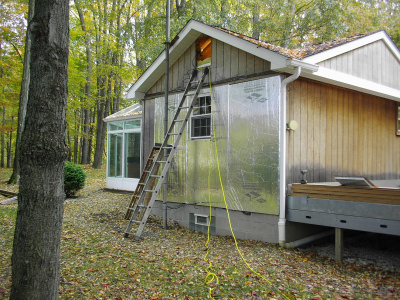
With his supplies
compiled, Zimmy and his wife ripped off the inside
paneling and installed 6 mil plastic as a vapor barrier, putting
drywall over that. They tacked an additional two inches of
insulated foam board to the outside of the trailer and coated it with
1/2" of plywood. The resulting combination of insulation in the
walls
now reached R26.
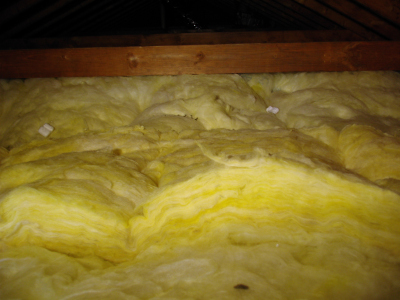
"The roof already had
R19 of fiberglass insulation in it and the
company I worked for sold me at cost bags of rock wool insulation,"
Zimmy wrote. It was simple to add more insulation under the roof,
bringing the insulative value up to at least R60.
Zimmy made sure that I
knew he still planned to put vinyl siding over
the outside walls of the mobile home. I could tell that the
insulating project had been a lot of work, but I'll bet he and his wife
consider that $500 a very wise investment.
| This post is part of our Energy Efficient Mobile Home lunchtime
series.
Read all of the entries: |
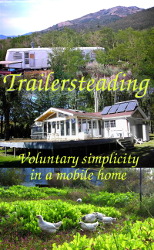
Edited to add:
Learn more about insulating and improving the efficiency of a mobile
home in Trailersteading. Now available for
$1.99 on Amazon.

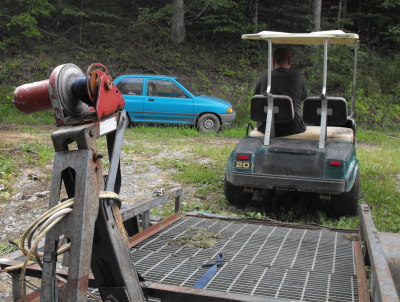
This is Golf Cart Gary. He's the guy to go to if you need help getting
your golf cart fixed.
Gary came and picked her up,
took her back to his lab, fixed a burned out wire, and delivered her
back to a waiting Lucy for only 60 dollars.
I think I may need to consider modifying the golf cart under carriage
to be more water proof to avoid another break down like this.

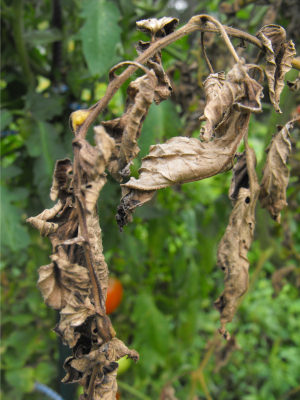 Although
I thoroughly enjoyed last week's
deluge, the tomatoes
didn't. I had been keeping a pretty good handle on the early
blight, but several
days of damp spread other fungi and I can tell our tomatoes
are now on the decline.
Although
I thoroughly enjoyed last week's
deluge, the tomatoes
didn't. I had been keeping a pretty good handle on the early
blight, but several
days of damp spread other fungi and I can tell our tomatoes
are now on the decline.
The pictures at the top
of the post show our new septoria leaf spot
infection. At a quick glance, these spots look a lot like early
blight, but notice that the septoria spots are smaller, more numerous,
have a
pale center, and aren't ringed by a halo of yellow. (There is
some yellowing on the leaf, but it doesn't encircle the spots.)
Meanwhile, late blight
has struck as well. About a third of the leaves on a
couple of plants have curled up and turned brown, and I'm beginning to
see rotten tomatoes on the vine.
Perhaps if the septoria
and late blight had hit the tomato patch during dry weather, I would
have been able to use extreme pruning to keep them at bay. But
somewhere in the course of last week's dozen inches of rain, the
septoria managed to colonize every tomato plant in our garden,
infecting even the upper leaves. My only option is to harvest as
fast as possible and accept that our tomatoes won't be much longer in
this world.
Despite all of this
death and destruction, I can't complain. We're close to our goal
of frozen tomato products --- enough to make pizza, spaghetti, and
vegetable soup twice a month apiece for an entire year. I was
hoping to experiment with ketchup and add some dried tomatoes to the
larder, but at this point I'm happy to take what I can get.
 Although
I usually think that buying insulation for the ceiling is the quickest
and cheapest way to improve heating efficiency, one
article I read
suggested that I was on the wrong track. They noted that
infiltration and air leakage are the most problematic causes of heat
loss in the winter, making up around 35% of all heat lost from the
average home. Windows and doors followed behind at 18 to 20%,
then floors at 15 to 18%, walls at 12 to 14%, and finally ceilings at
10%. Clearly, fixing any holes or cracks should be your first
priority, closely followed by dealing with windows and doors.
Although
I usually think that buying insulation for the ceiling is the quickest
and cheapest way to improve heating efficiency, one
article I read
suggested that I was on the wrong track. They noted that
infiltration and air leakage are the most problematic causes of heat
loss in the winter, making up around 35% of all heat lost from the
average home. Windows and doors followed behind at 18 to 20%,
then floors at 15 to 18%, walls at 12 to 14%, and finally ceilings at
10%. Clearly, fixing any holes or cracks should be your first
priority, closely followed by dealing with windows and doors.
 We
installed double-glazed windows in our trailer, but even the air gap
between those panes of glass is a drop in the bucket.
Double-glazed windows tend to have an R-value around 2 --- compared to
a preferred R-value
of at least 13 in walls. Is there a way to
make windows more efficient without living in a cave?
We
installed double-glazed windows in our trailer, but even the air gap
between those panes of glass is a drop in the bucket.
Double-glazed windows tend to have an R-value around 2 --- compared to
a preferred R-value
of at least 13 in walls. Is there a way to
make windows more efficient without living in a cave?
Zimmy made some quick
and easy window coverings to insulate his windows when they aren't in
use. He used foam board on basement windows and some upstairs
windows (top photo), then bought quilted window blinds for windows in
his main living space (second photo.) The quilted blinds run on a
track and 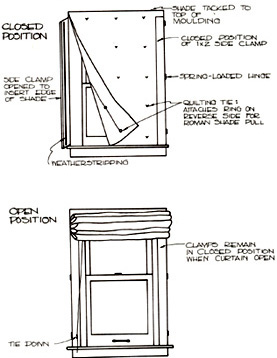 seal
all around the window. I estimate that Zimmy gets an additional
R-6 from his foam board (although the gaps at the edge of the foam
board may drop this down some) and perhaps as high as R-7 for his
quilted blinds.
seal
all around the window. I estimate that Zimmy gets an additional
R-6 from his foam board (although the gaps at the edge of the foam
board may drop this down some) and perhaps as high as R-7 for his
quilted blinds.
Maine
Home Energy has a
very well put together page about different window insulation options,
including price per square foot and R-value of each. They
recommend quilted blinds like Zimmy's (which they call "insulated Roman
shades") on south-facing windows since they are easy to open for
passive solar gain on sunny days, then seal shut for the night or on
cloudy days. Insulating windows has always been on our priority
list, but after reading the statistics on heat lost through windows,
then seeing simple how-to instructions for making our own insulating
blinds, I think this project will have to move closer to the top.
| This post is part of our Energy Efficient Mobile Home lunchtime
series.
Read all of the entries: |

Edited to add:
Learn more about insulating and improving the efficiency of a mobile
home in Trailersteading. Now available for
$1.99 on Amazon.

The height of the summer busy
season is starting to calm down enough for us to dedicate some time to
getting the 2009
winter building project wrapped up.
With any luck we should have
the sky light boxed in and sealed up by the end of the week.
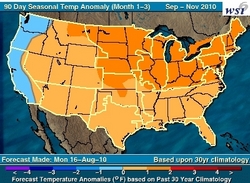 "Did
you know that we're forecast to have a warmer than average fall this
year?" I called to Mark as he set out to work on the shed's roof.
Mark came in and looked over my shoulder at this
prediction by Weather Services International that forecasts
abnormally warm temperatures through November everywhere in the U.S.
except on the Pacific coast.
"Did
you know that we're forecast to have a warmer than average fall this
year?" I called to Mark as he set out to work on the shed's roof.
Mark came in and looked over my shoulder at this
prediction by Weather Services International that forecasts
abnormally warm temperatures through November everywhere in the U.S.
except on the Pacific coast.
"What would you do
differently if you knew the growing season was going to extend for an
extra month?" Mark probed. Well, that was easy --- I would start
a lot more of the fall
crops that didn't
come up in the dog days' heat, tricking them into germinating indoors
in flats then transplanting them to the garden.
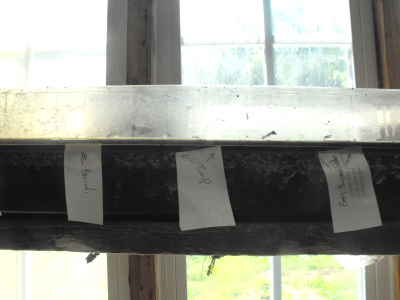 Our
traditional first frost date is October 10 --- 46 days away --- and I
need about 55 to 70 growing days to make it worthwhile to replant all
of the roots and cabbages that failed me in the garden. Even that
is an optimistic estimate, since you should usually add two weeks to
the "days to harvest" on your seed packet when planning fall crops to
take into account shorter days as the year fades. I figured there
was no way fall crops would have time to mature if I planted them this
late, so I assumed we'd just make do without them.
Our
traditional first frost date is October 10 --- 46 days away --- and I
need about 55 to 70 growing days to make it worthwhile to replant all
of the roots and cabbages that failed me in the garden. Even that
is an optimistic estimate, since you should usually add two weeks to
the "days to harvest" on your seed packet when planning fall crops to
take into account shorter days as the year fades. I figured there
was no way fall crops would have time to mature if I planted them this
late, so I assumed we'd just make do without them.
But what if the killing
frost really did hold off for an extra few weeks? Isn't it worth
wasting a dollar's worth of seed on a gamble if you could instead win a
bushel of carrots, beets, cabbage, broccoli, and turnips? I
wonder what it says about me that I would never buy a lottery ticket
but have no problem gambling on the garden?
 I
can just hear Roland
now --- "All of this talk about insulating the
home is great, but you shouldn't be using electricity for heat
anyway. What did Zimmy do to lower his non-heat electricity use
before going off the grid?" Well Roland-in-my-head, I'm glad you
asked that, because Zimmy went all out.
I
can just hear Roland
now --- "All of this talk about insulating the
home is great, but you shouldn't be using electricity for heat
anyway. What did Zimmy do to lower his non-heat electricity use
before going off the grid?" Well Roland-in-my-head, I'm glad you
asked that, because Zimmy went all out.
Zimmy installed aluminum
bars on his baseboard heaters as a thermal
heat sink and bought a Geyser heat pump water heater. In the
kitchen, he put in a Sunfrost refrigerator,  an induction cook top, and
a vent to channel excess heat to the water heater (or outside.)
He
switched over to Energy Star appliances, buying a new freezer among
other things. Finally, he installed a dual flush conversion on
the toilet to help save water.
an induction cook top, and
a vent to channel excess heat to the water heater (or outside.)
He
switched over to Energy Star appliances, buying a new freezer among
other things. Finally, he installed a dual flush conversion on
the toilet to help save water.
I wasn't surprised to
see fluorescent and LED lighting on Zimmy's list,
but I did get hung up for a moment on what a solar tube is. These
special skylights use a combination of a domed "daylight capturing
surface" on the outside of the house and a lens on the inside of the
house to maximize the amount of sunlight you receive through a small
skylight. Solar tubes are sure to warm the inventive cockles of
Mark's heart, but at a few hundred dollars apiece, we won't be
installing them anytime soon.
| This post is part of our Energy Efficient Mobile Home lunchtime
series.
Read all of the entries: |
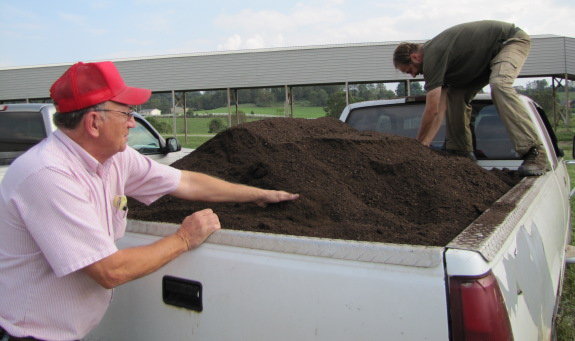
This is Spike, it was nice of
him to help me smooth out our 4th load of chicken manure compost.
It took the previous 3 loads
for me to wise up to the idea of covering the entire truck bed with a
large tarp, which most likely helped to save several 5 gallon buckets
worth from blowing away during the trip back.
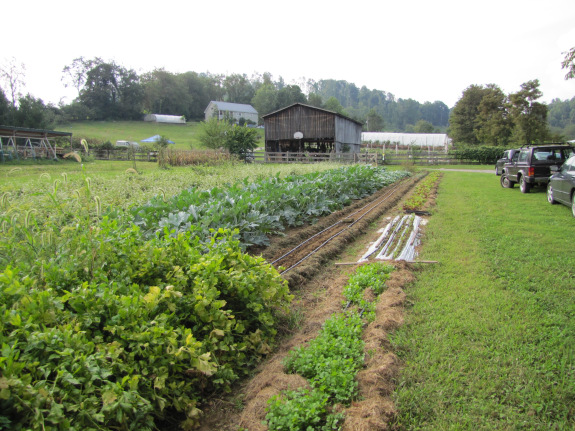
 Wednesday,
Mark and I attended a riveting presentation about biochar at Abingdon
Organics, the home
and farm of Anthony and Laurel Flaccavento. The first time I
toured Anthony's farm, I was blown away by his experiments, and by the
colors and sheer beauty of his crops. I figured there was no way
I could ever achieve such perfection.
Wednesday,
Mark and I attended a riveting presentation about biochar at Abingdon
Organics, the home
and farm of Anthony and Laurel Flaccavento. The first time I
toured Anthony's farm, I was blown away by his experiments, and by the
colors and sheer beauty of his crops. I figured there was no way
I could ever achieve such perfection.
Even though he's still
head and shoulders above us, I actually felt a little better about my
own garden after this visit. Anthony's tomatoes were keeling over
even faster than ours (although he had been eating them since May) and he told us that this
was the worst year he'd ever seen for Mexican bean beetles. I
guess misery loves company....
On
the other hand, Anthony never throws in the towel, even when faced with
total bean defoliation. He discovered that you can buy a
 parasitic wasp (Pediobius
foveolatus) that
will lay its eggs inside the bean beetle larvae and wipe out your
infestation...at least for a season. The brown larva shown here
is a parasitized bean beetle that won't do any more eating on Anthony's
beans. (In the background, you can see a yellowish, unparasitized
larva of the same age.)
parasitic wasp (Pediobius
foveolatus) that
will lay its eggs inside the bean beetle larvae and wipe out your
infestation...at least for a season. The brown larva shown here
is a parasitized bean beetle that won't do any more eating on Anthony's
beans. (In the background, you can see a yellowish, unparasitized
larva of the same age.)
Unfortunately, Pediobius wasps are tropical imports
and won't overwinter in our climate, so you have to keep buying them
each year, making the proposition less sustainable than I  would
like. Still, if you're dying to grow beans and the Mexican bean
beetle is your archnemesis, you should give Tom Dorsey a call at
609-530-4192. He doesn't appear to have a website, but is
Anthony's wasp source.
would
like. Still, if you're dying to grow beans and the Mexican bean
beetle is your archnemesis, you should give Tom Dorsey a call at
609-530-4192. He doesn't appear to have a website, but is
Anthony's wasp source.
Stay tuned for more
tidbits from our exciting day in the big city (and, hopefully, a
lunchtime series on biochar!) Meanwhile, I have to end with
another highlight of our trip --- meeting two loyal blog readers who
came over to compliment us on the Walden Effect. Thanks for your kind
words, Rocky (and sister, whose name I didn't quite catch.)
 Zimmy
and his wife rounded out their energy efficient home by producing some
of their own power. They live in northern Ohio where it makes
sense to supplement solar power by capturing the wind blowing down off
the Great Lakes.
Zimmy
and his wife rounded out their energy efficient home by producing some
of their own power. They live in northern Ohio where it makes
sense to supplement solar power by capturing the wind blowing down off
the Great Lakes.
The couple has been
building their homestead infrastructure
for about as long as I've been alive, so it's no surprise they've been
able to snap up good deals. "Almost everything we buy, build,
install, is seconds. We live in the world of surplus," Zimmy emailed
when I asked him the cost of his alternative energy system. He
went on to say that he has two different sets of solar panels as well
as the wind turbine.
 The solar panels on the ground put out about
3kw. They came from a demonstration solar power plant in the
south California desert. After being cooked in the sun with
concentrating mirrors they were dumped onto the surplus market. I
installed them in 1994. I don't remember the cost, but it was cheap at
the time.
The solar panels on the ground put out about
3kw. They came from a demonstration solar power plant in the
south California desert. After being cooked in the sun with
concentrating mirrors they were dumped onto the surplus market. I
installed them in 1994. I don't remember the cost, but it was cheap at
the time. The panels on the roof were installed last year by Mary and I. They are a 1.6kw array, and they came from http://www.sunelec.com/ as seconds.
The [17.5 kw] wind turbine....well that's another story. It was installed in 1984. The turbine was bought as a damaged unit that was damaged in a wind storm. The tower was bought from a scrap yard and they bought it from the local airport. I also found other sections of the same type tower from another person. The tower is 150' tall and I have 20' left over to be used for my water tower when I get time. The turbine has been hit by lighting several times, mechanical failures, electrical failures, modified and upgraded several times. I have lost track of the cost, but I have a spare alternator, gearhead, governor, blades, and spare inverter boards. The turbine had some damage over the winter that cost $3,500 for repairs but insurance paid for it.
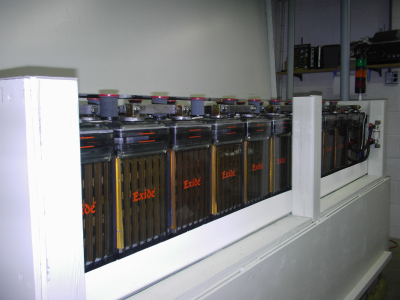 Whenever
I consider alternative power --- beyond our simple
solar
backup --- I get caught up in the disposable nature of batteries
and
whether the unit will really pay for itself. Unfortunately, Zimmy
wasn't really able to answer my questions about the economics of his
grid-tied system. He noted: "I don't keep track of power produced
and power used. We use every bit of power we produce, and have
some amount of electric bill to pay. The utility co. is happy and
so are we."
Whenever
I consider alternative power --- beyond our simple
solar
backup --- I get caught up in the disposable nature of batteries
and
whether the unit will really pay for itself. Unfortunately, Zimmy
wasn't really able to answer my questions about the economics of his
grid-tied system. He noted: "I don't keep track of power produced
and power used. We use every bit of power we produce, and have
some amount of electric bill to pay. The utility co. is happy and
so are we."Whether or not Zimmy's system is cost-effective, I can tell he's had a wonderful time tinkering. Keeping our eyes open for salvage and seconds is a good lesson for everyone to learn.
Achieve true freedom with Microbusiness Independence.
| This post is part of our Energy Efficient Mobile Home lunchtime
series.
Read all of the entries: |
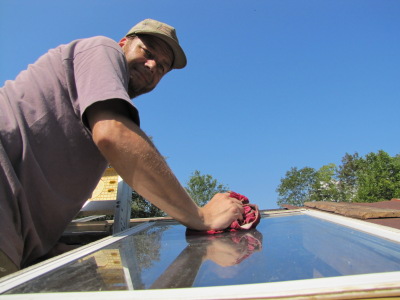
This skylight will be right above my bed so that I can look out at any
stars in the night sky while I'm drifting off to sleep.
After I've got it all sealed
up I'll make some sort of shutter that can be closed during the day.
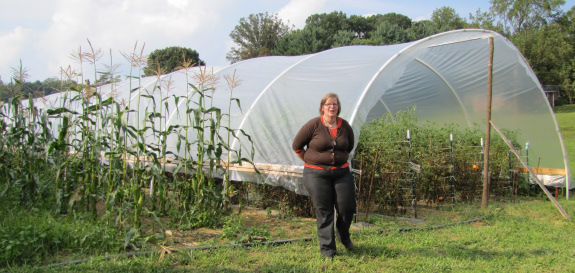
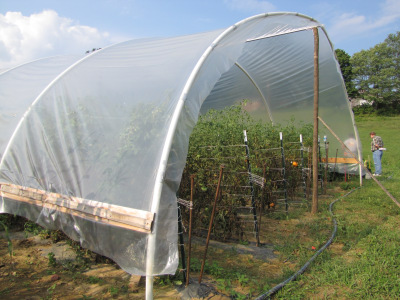 One
of the first aspects to catch your eye at Abingdon
Organics is half a
dozen high tunnels. Anthony Flaccavento uses these 150 foot long
hoop houses to give his plants a head start in the spring --- his
secret to having May tomatoes without heating a greenhouse.
One
of the first aspects to catch your eye at Abingdon
Organics is half a
dozen high tunnels. Anthony Flaccavento uses these 150 foot long
hoop houses to give his plants a head start in the spring --- his
secret to having May tomatoes without heating a greenhouse.
The first high tunnels
at Abingdon Organics were purchased for thousands of dollars apiece,
but the newest hoop houses are DIY versions. Imagine 4,500 square
feet of protected growing area for just $900.
Anthony and his farm
manager built the DIY high tunnels from locust posts, a steel purline,
PVC pipes, brackets, and a huge sheet of plastic. Clearly, the
hoop houses are still being perfected, and Anthony noted that he lost
two during heavy storms this summer. Still, at a cost of only
about 20 cents per square foot, his high tunnel design is definitely
worth continued experimentation.
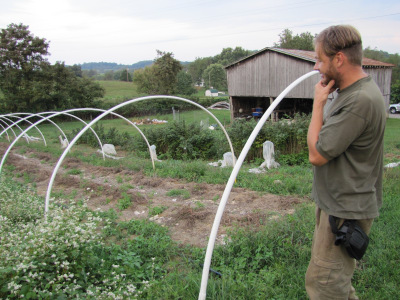 Mark's
ears perked right up when Anthony started discussing homemade hoop
houses, but I had to point out the negatives. Like any greenhouse
or other protected area, Anthony's high tunnels become breeding grounds
for molds and spider mites. Mark's rebuttal is that we could
easily build a small, movable unit that was just used to give the
tomatoes a couple of months' head start. Clearly, cheap, DIY high
tunnels are making their way onto the drawing board.
Mark's
ears perked right up when Anthony started discussing homemade hoop
houses, but I had to point out the negatives. Like any greenhouse
or other protected area, Anthony's high tunnels become breeding grounds
for molds and spider mites. Mark's rebuttal is that we could
easily build a small, movable unit that was just used to give the
tomatoes a couple of months' head start. Clearly, cheap, DIY high
tunnels are making their way onto the drawing board.


We had a great afternoon
learning some of the basics of sailing from Anna's mom. Thanks Adrianne.
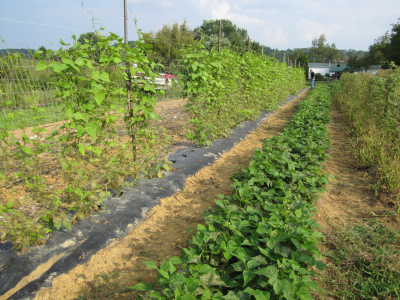 Roland sent me a link to an
intriguing article in the New York Times called "Math
Lessons for Locavores."
The author argues that locavores need to take a harder look at the
facts and realize that the distance food travels before it reaches
their plates accounts for only 14% of the total energy costs of their
eating habits. While I like Stephen Budiansky's focus on numbers,
the author's conclusion doesn't make as much sense to me. He ends
his article by saying, in essence, that our current agricultural system
is just peachy. I couldn't agree less.
Roland sent me a link to an
intriguing article in the New York Times called "Math
Lessons for Locavores."
The author argues that locavores need to take a harder look at the
facts and realize that the distance food travels before it reaches
their plates accounts for only 14% of the total energy costs of their
eating habits. While I like Stephen Budiansky's focus on numbers,
the author's conclusion doesn't make as much sense to me. He ends
his article by saying, in essence, that our current agricultural system
is just peachy. I couldn't agree less.
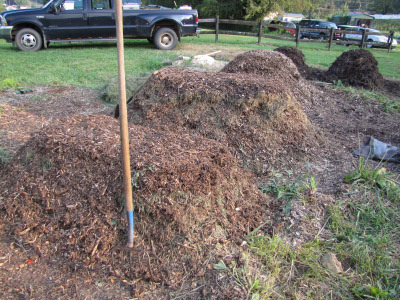 Here's
a quick example to help you see one small reason why I think that even
mainstream organic farming is fatally flawed. While touring Abingdon
Organics, I was
shocked to hear that Anthony tosses 200 pounds of culled tomatoes and
peppers in his compost pile every week. Mark and I once attended
a few meetings as potential growers for Anthony's organic gardening
marketing association, and I can personally attest that those culls
aren't nearly as bad as the tomato I
chewed Mark out for throwing to the chickens a few weeks ago.
Chances are, the culled vegetables had a slightly odd shape, were too
big or too small, or had a minute blemish. A hundred years ago,
those culls would have been known as "food", or, at the worst, would
have fed pigs or chickens that would quickly become human food.
Here's
a quick example to help you see one small reason why I think that even
mainstream organic farming is fatally flawed. While touring Abingdon
Organics, I was
shocked to hear that Anthony tosses 200 pounds of culled tomatoes and
peppers in his compost pile every week. Mark and I once attended
a few meetings as potential growers for Anthony's organic gardening
marketing association, and I can personally attest that those culls
aren't nearly as bad as the tomato I
chewed Mark out for throwing to the chickens a few weeks ago.
Chances are, the culled vegetables had a slightly odd shape, were too
big or too small, or had a minute blemish. A hundred years ago,
those culls would have been known as "food", or, at the worst, would
have fed pigs or chickens that would quickly become human food.
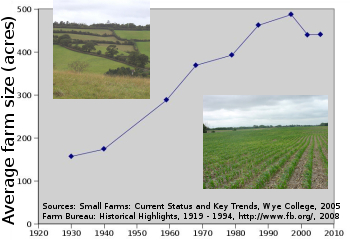 In
my opinion, the problem with mainstream agriculture is not the miles
food travels to get to our plates; the problem is sheer size.
Over the last hundred years, farmers
have been forced to grow food on larger and larger acreages or go out
of business, with
the result that they simply cannot keep the farm ecosystem
balanced. Pollution from concentrated animal feeding operations
is yet another example. Just as today's culls used to turn into
yesteryear's soups, today's problem manure used to be yesteryear's
black gold.
In
my opinion, the problem with mainstream agriculture is not the miles
food travels to get to our plates; the problem is sheer size.
Over the last hundred years, farmers
have been forced to grow food on larger and larger acreages or go out
of business, with
the result that they simply cannot keep the farm ecosystem
balanced. Pollution from concentrated animal feeding operations
is yet another example. Just as today's culls used to turn into
yesteryear's soups, today's problem manure used to be yesteryear's
black gold.
 Although
the average eater can't shut down factory farms or change the policies
that make the typical American farm a 400 acre monoculture, we can take
simple actions that will start to change the system. Forget the
greenwashing labels on the food from the grocery store and start
thinking about your own growing, cooking, and refrigerating
habits. In "Math Lessons for Locavores", Stephen Budiansky wrote
that 32% of food energy costs come from refrigerating and cooking that
food at home. If you grow your own vegetables, you won't need to
run one of those huge refrigerators that grace the modern home --- you
just take the food out of the garden, cook gently, and throw it on your
plate, putting the leftovers in a smaller, energy-efficient
model. A rocket stove is on our winter project list to further
lower our energy footprint.
Although
the average eater can't shut down factory farms or change the policies
that make the typical American farm a 400 acre monoculture, we can take
simple actions that will start to change the system. Forget the
greenwashing labels on the food from the grocery store and start
thinking about your own growing, cooking, and refrigerating
habits. In "Math Lessons for Locavores", Stephen Budiansky wrote
that 32% of food energy costs come from refrigerating and cooking that
food at home. If you grow your own vegetables, you won't need to
run one of those huge refrigerators that grace the modern home --- you
just take the food out of the garden, cook gently, and throw it on your
plate, putting the leftovers in a smaller, energy-efficient
model. A rocket stove is on our winter project list to further
lower our energy footprint.
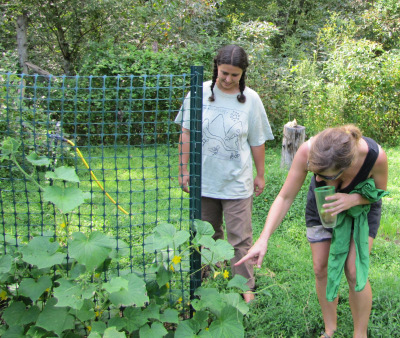 Truthfully,
though, I think that even those steps are a bit cosmetic. The
real way to make your eating habits an asset to the planet rather than
an oozing sore is to grow your own food on a small enough scale that
you can put all of the "waste" back into the farm to feed the
soil. Although you don't hear it bandied about much, I see no
reason why adding compost to your soil and growing cover crops wouldn't
count as carbon sequestration --- after all, humus can take up to a
thousand years to decompose. Add in some livestock to make the
ecosystem more complete, and you've got a simple permaculture farm that
feeds butterflies and birds as well as humans.
Truthfully,
though, I think that even those steps are a bit cosmetic. The
real way to make your eating habits an asset to the planet rather than
an oozing sore is to grow your own food on a small enough scale that
you can put all of the "waste" back into the farm to feed the
soil. Although you don't hear it bandied about much, I see no
reason why adding compost to your soil and growing cover crops wouldn't
count as carbon sequestration --- after all, humus can take up to a
thousand years to decompose. Add in some livestock to make the
ecosystem more complete, and you've got a simple permaculture farm that
feeds butterflies and birds as well as humans.
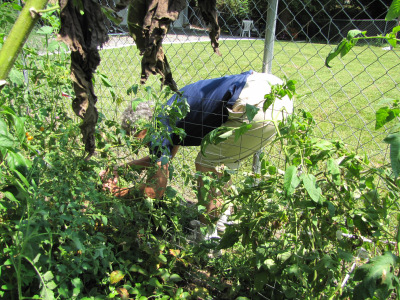 If
growing your own food is so great, why don't we see more people jumping
on the bandwagon? Well, there's very little profit in it, for one
thing, so marketers feel no need to spread the word. Growing your
own food also takes time and effort, and we're all inherently lazy
people who would far rather think we were changing the world by paying
double for a zucchini marked "organic" than putting down a kill mulch
in the backyard and getting to work. To top our reasons off,
everyone knows that the average American is far too busy to commit 15
hours a week to growing crops, even though we easily spend that much
time in front of a TV. And, heck, what can one person's actions
do? How quickly we forget that during World War II, little
backyard victory gardens
produced 40% of Americans' food.
If
growing your own food is so great, why don't we see more people jumping
on the bandwagon? Well, there's very little profit in it, for one
thing, so marketers feel no need to spread the word. Growing your
own food also takes time and effort, and we're all inherently lazy
people who would far rather think we were changing the world by paying
double for a zucchini marked "organic" than putting down a kill mulch
in the backyard and getting to work. To top our reasons off,
everyone knows that the average American is far too busy to commit 15
hours a week to growing crops, even though we easily spend that much
time in front of a TV. And, heck, what can one person's actions
do? How quickly we forget that during World War II, little
backyard victory gardens
produced 40% of Americans' food.
I'll step down off my
soapbox now. Thanks for reading a post that got way too
long! Feel free to tear my reasoning apart in the comments.
 In
my opinion the biggest benefit you can gain from growing
your own food is the ultra freshness, which removes all the middle
men involved in conventional food production.
In
my opinion the biggest benefit you can gain from growing
your own food is the ultra freshness, which removes all the middle
men involved in conventional food production.
I think it may be one of the
most efficient ways to reconnect more with the rhythm of nature.
For me the change was gradual
and I didn't notice the full impact of the reward until about the 2
year point of my WaldenEffect journey.
 Congratulations, Jessica and Bladerunner ---
you are both giveaway winners! Jessica won our most recent Egyptian
onion giveaway,
while Bladerunner won our
previous giveaway.
Drop me an email with your mailing address and
I'll put your goodies in the mail ASAP.
Congratulations, Jessica and Bladerunner ---
you are both giveaway winners! Jessica won our most recent Egyptian
onion giveaway,
while Bladerunner won our
previous giveaway.
Drop me an email with your mailing address and
I'll put your goodies in the mail ASAP.
I get the feeling
Bladerunner doesn't check our blog every day --- tsk, tsk --- and these
onions need to get in the ground. So, if I don't hear from
Bladerunner by Thursday morning, I'll send all of the top bulbs to
Jessica. But don't despair --- the rest of your goodies will be
waiting for you when you check in.
If anyone can think of a
better way for me to get in touch with giveaway winners rather than
hoping they'll read my announcement entry, I'd be glad to hear
it. I don't want them to have to leave their email addresses on
the blog, and I also don't want to have to keep track of a slew of
emails in my own inbox, so I'm a bit flummoxed about other
solutions. Perhaps you've seen a better method elsewhere in the
blogosphere?
Although we clearly got
a lot out of visiting Abingdon
Organics, our real
purpose was to listen to several biochar experts talk about charcoal's
potential as a soil amendment. The seminar turned out to be the
most exciting presentation I'd attended in several years, so I was glad
that Mark filmed the whole thing. Once we got home, I edited the
video down into bite-size segments for your lunchtime enjoyment this
week.
Today's video is an
introduction to biochar. What is it? Does it occur in
nature? Is biochar the same as terra preta? Watch the video
and find out.
| This post is part of our Biochar Videos lunchtime series.
Read all of the entries: |
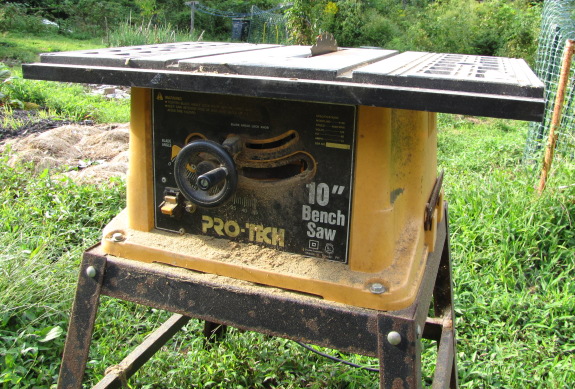
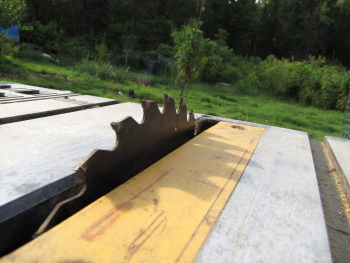
This 10 inch Pro-Tech bench saw has made some of the really hard cuts
for our latest building project a breeze.
I would say it's a must have
if you want to get clean and crisp cuts without wearing out your arms
using a hand saw.
You can use a reciprocating saw
to do most of these applications with a lot less accuracy and neatness.
Once you get a taste of the table saw you'll feel like you can't live
without one if you want to make the occasional building project
painless and fun.
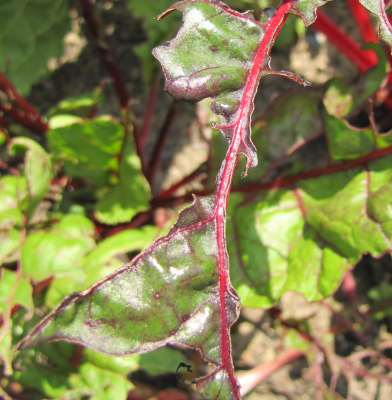 I've
been known to tell people that swiss
chard is the easiest vegetable to grow since nothing seems to eat
it. I won't be saying that anymore.
I've
been known to tell people that swiss
chard is the easiest vegetable to grow since nothing seems to eat
it. I won't be saying that anymore.
You see, an absolutely
adorable, striped insect showed up around the swiss chard this summer,
and I left the critter alone because it was so cute. Only weeks
later did I catch the chomper in action and figure out why it was so
plump.
The disillusionment made
me so mad at my buddies that I smashed every single one, so I don't
have a photo to show you (nor can I figure out what the bad bug 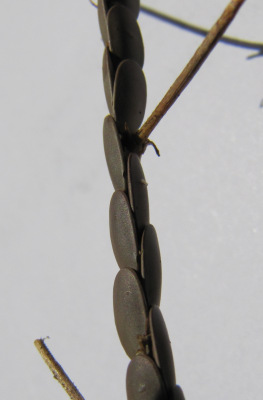 was.)
was.)
Even though it set me
way behind my frozen greens allotment for the summer, my swiss chard
insect taught me a good lesson --- identify, identify, identify!
Now, whenever a new insect shows up in my life, I pull out the books
and figure out what it is right away.
During my weekly bug
picking and smashing expedition Monday, I came across these fascinating
grey scales shingling a dead asparagus twig. Ten minutes later, I
knew that they were mostly harmless --- just katydid eggs to serenade
me to sleep next year. Thank goodness!
Part 2 of our biochar
video series covers
the benefits of biochar. One backyard enthusiast calls the
charcoal "condos for microbes," and biochar also has a host of other
beneficial properties in the soil. Julie Major from the International Biochar
Initiative and Rory
Maguire from Virginia Tech point out biochar's most impressive features
in this short video.
| This post is part of our Biochar Videos lunchtime series.
Read all of the entries: |
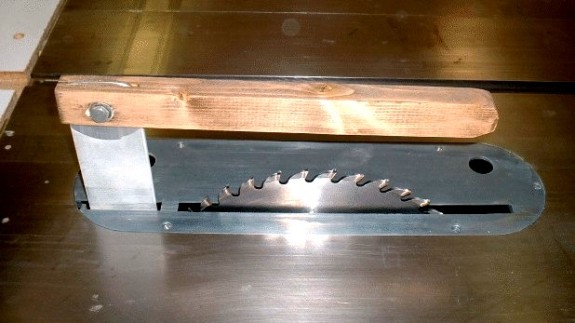
Roland made a good safety point on my post yesterday that sent me back 25 years to Mr Beaver's woodshop class in
High School. Yes...that was his real name.
The Pro-Tech
10" bench saw was a
hand-me-down and already had the splitter removed. I think I've got it in the barn somewhere.
I decided to take Roland's
advice and look into what it might take to replace the splitter, which
is a piece of metal that prevents the cut wood from drifting back to
the blade.
The above picture is from The
Woodshop.com, a great
website that has encountered this problem due to the original
splitter/guard being too flimsy. They came up with a strudy do it
yourself version that looks easy to replicate. The guard only functions
to prevent scraps from being dropped onto the blade, but the splitter
seems like it should work better than the original.
Want more in-depth information? Browse through our books.
Or explore more posts by date or by subject.
About us: Anna Hess and Mark Hamilton spent over a decade living self-sufficiently in the mountains of Virginia before moving north to start over from scratch in the foothills of Ohio. They've experimented with permaculture, no-till gardening, trailersteading, home-based microbusinesses and much more, writing about their adventures in both blogs and books.
